Lecture 3 Word-formation in Modern English 1.



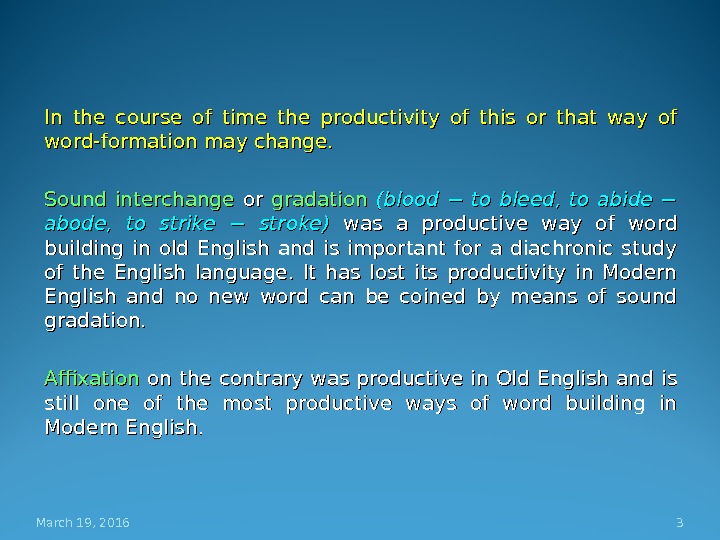




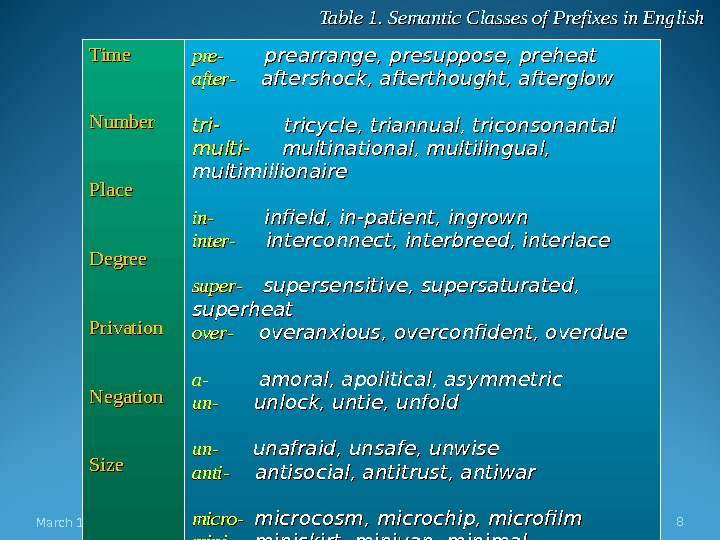

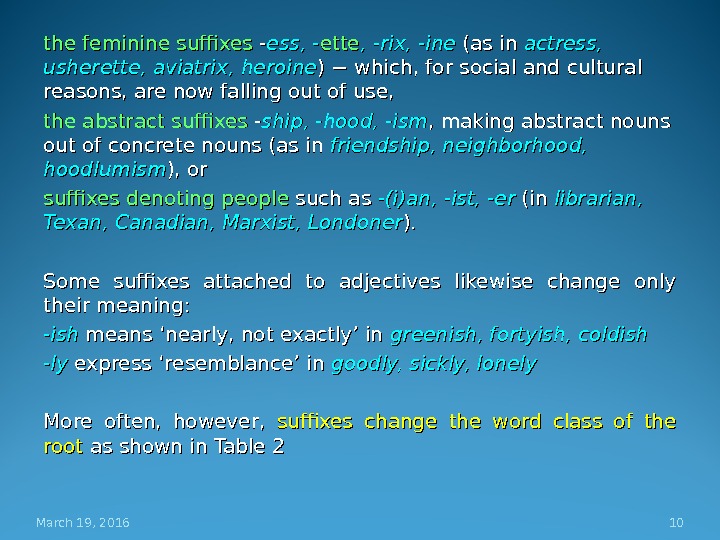
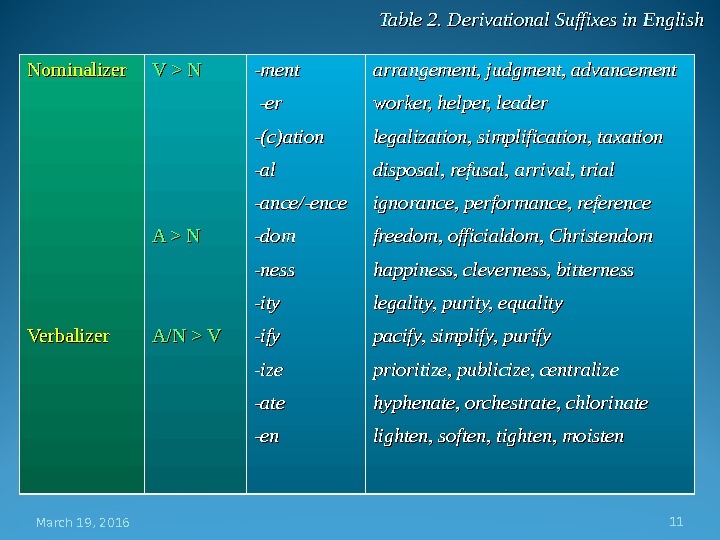
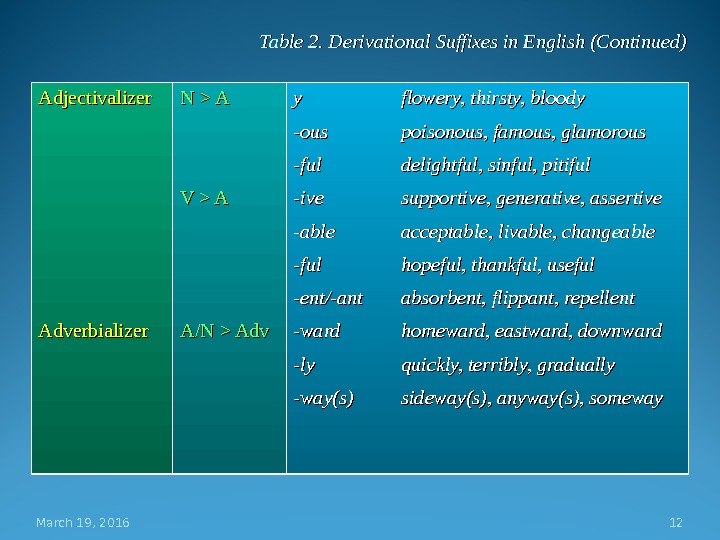


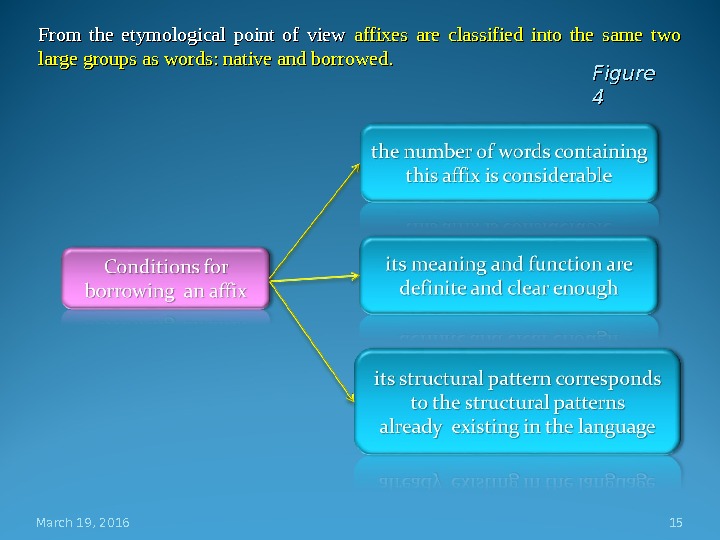



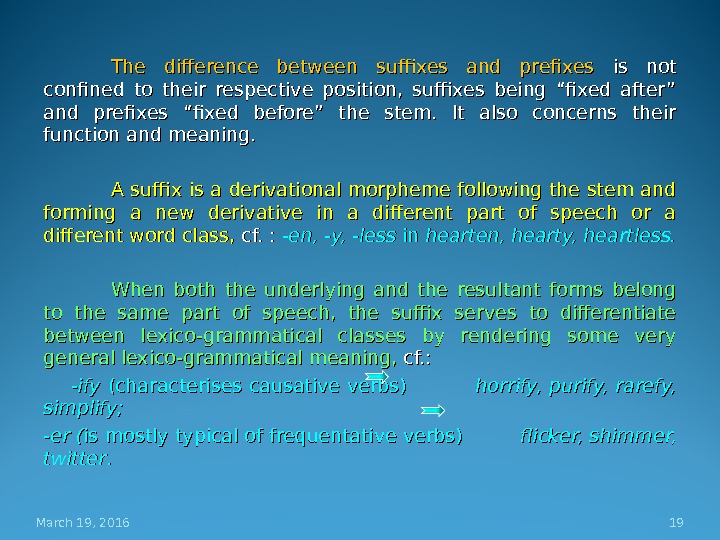
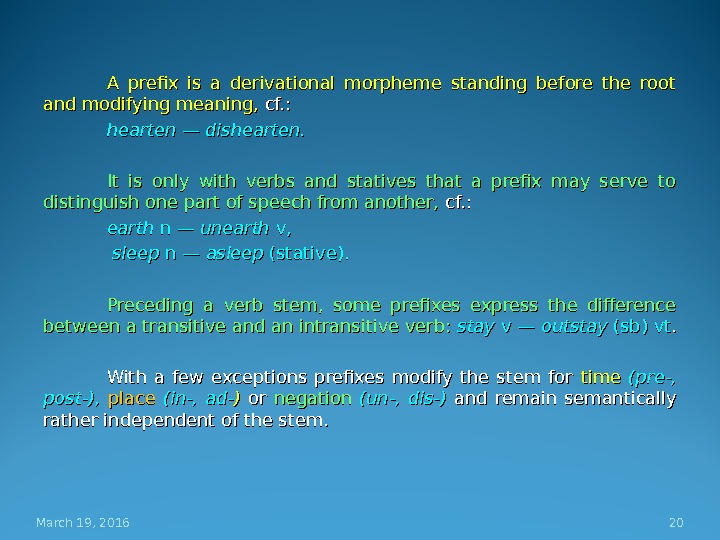




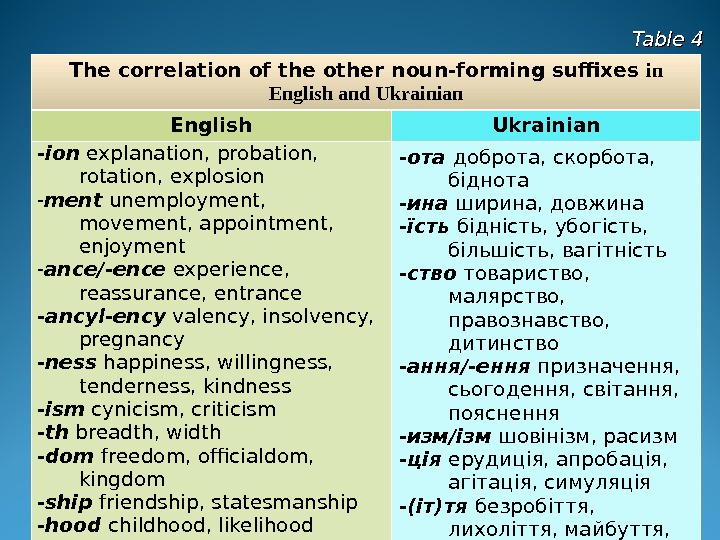

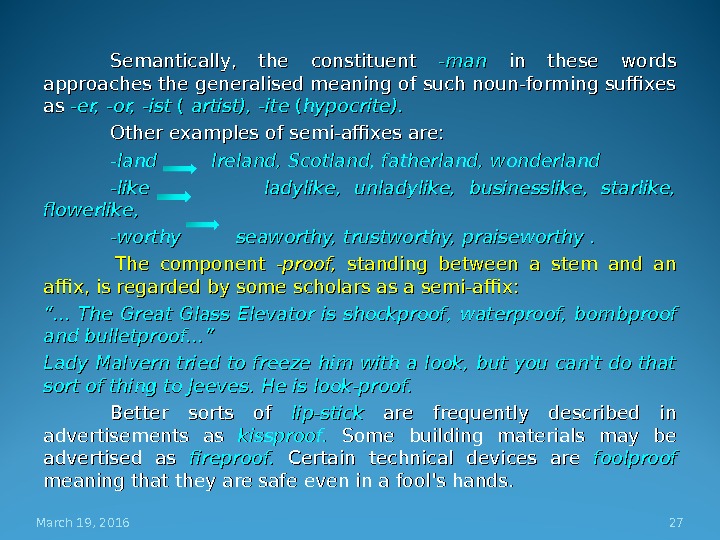
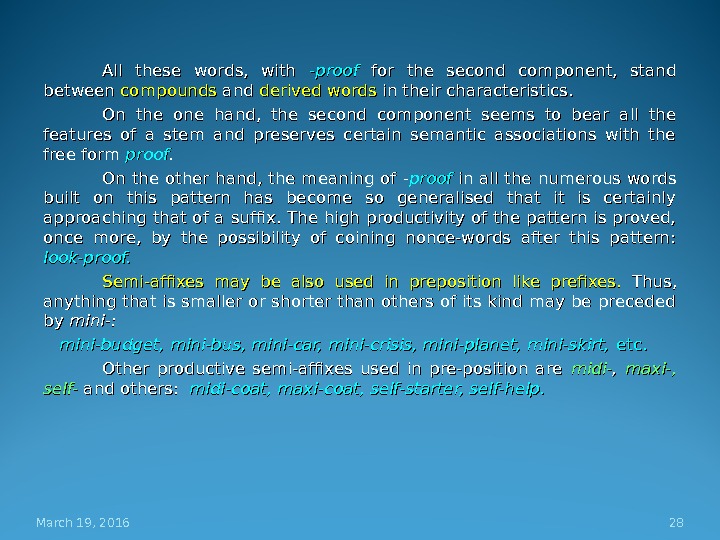
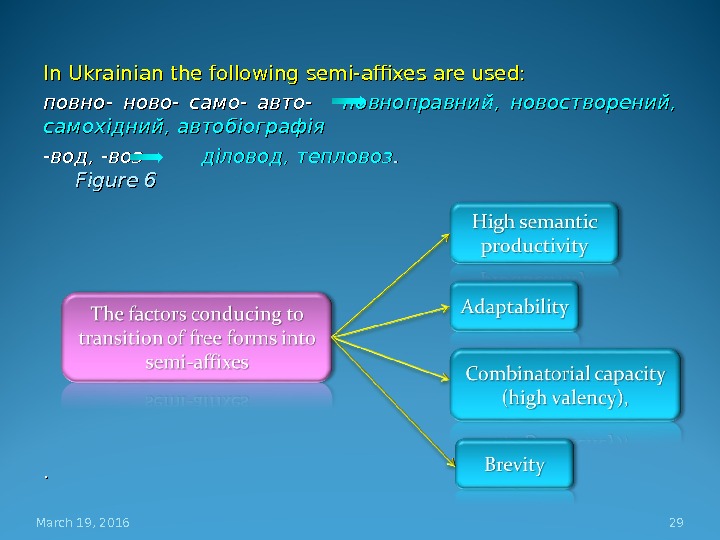


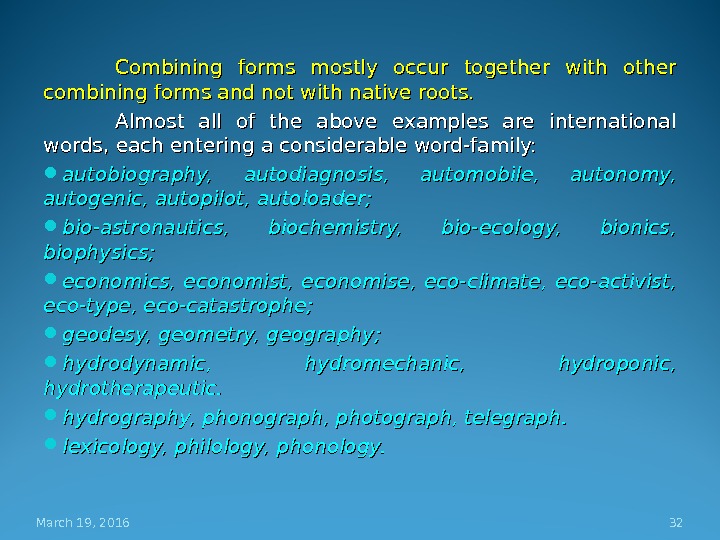

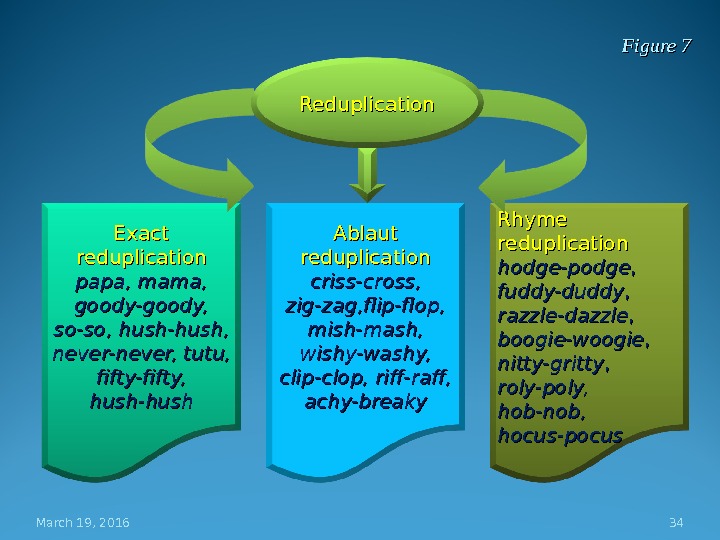
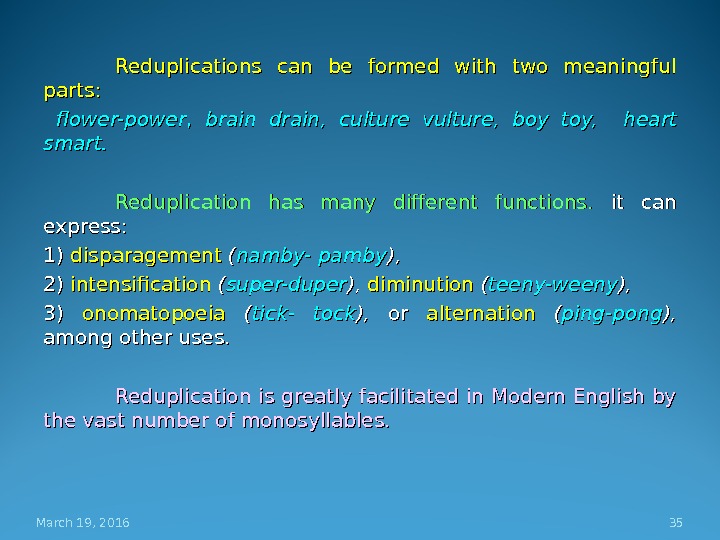


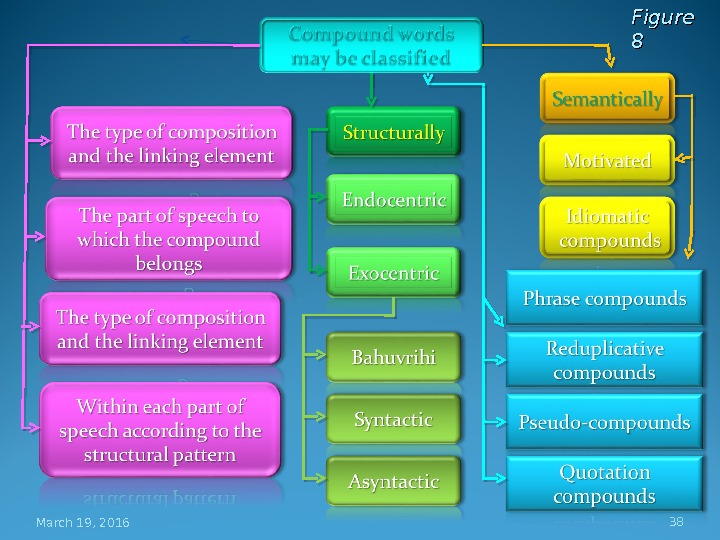
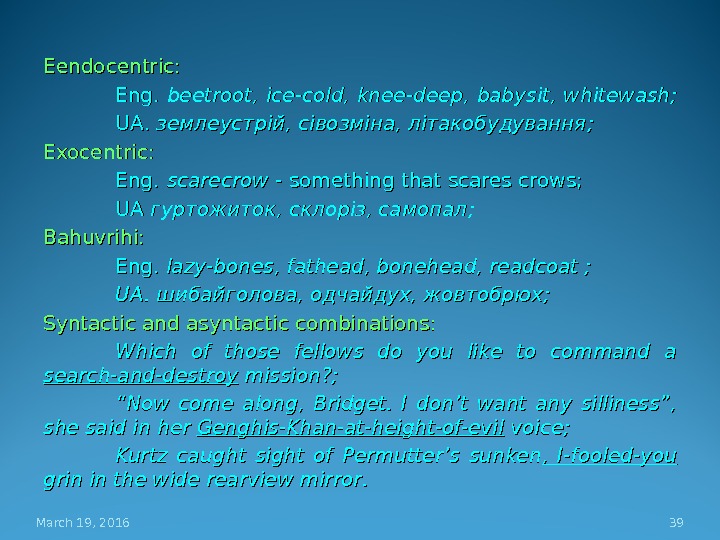


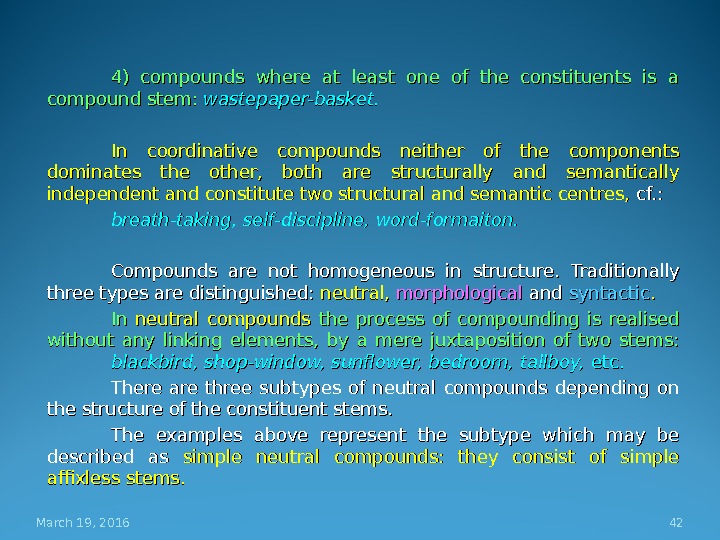

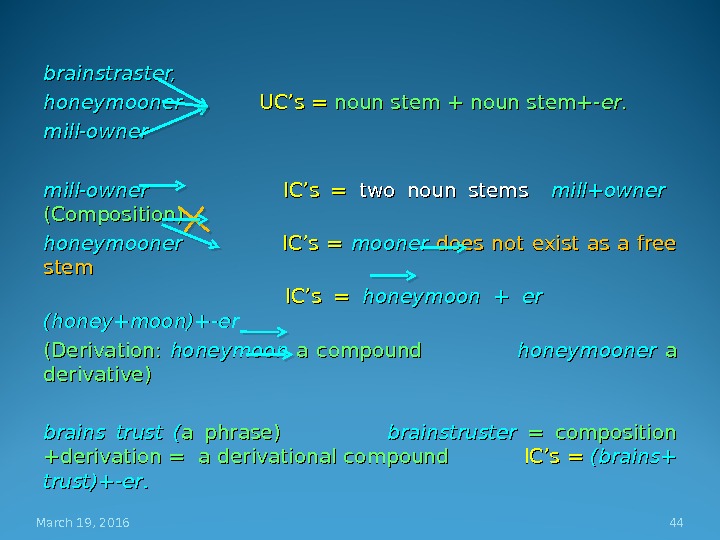
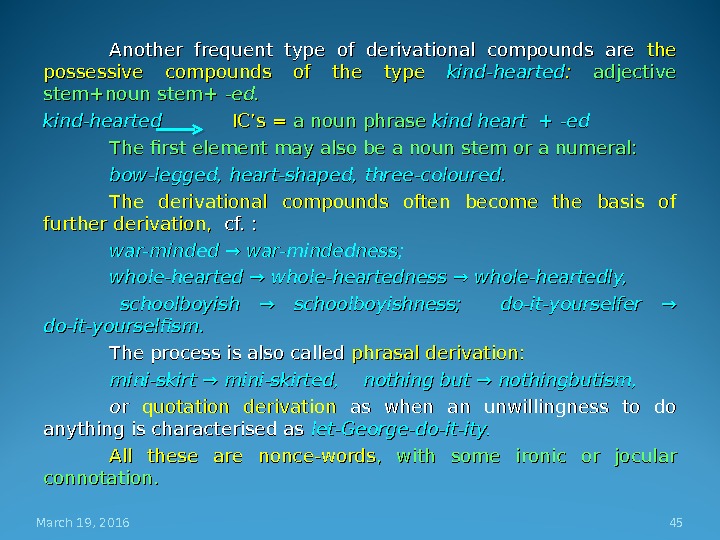



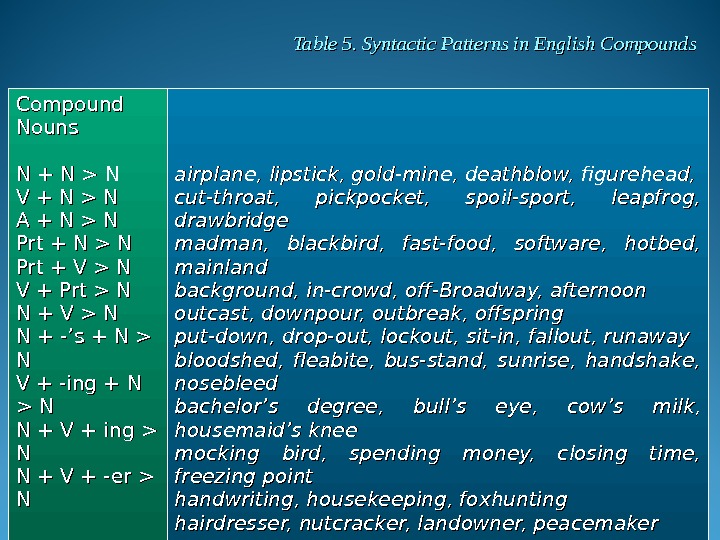
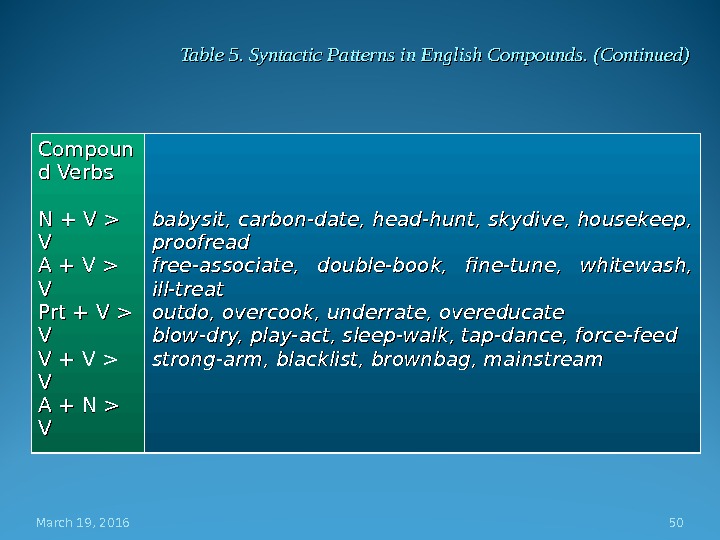
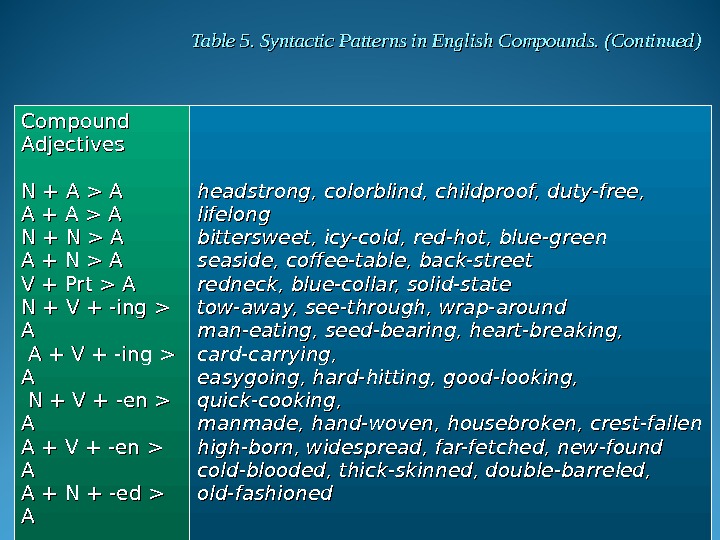
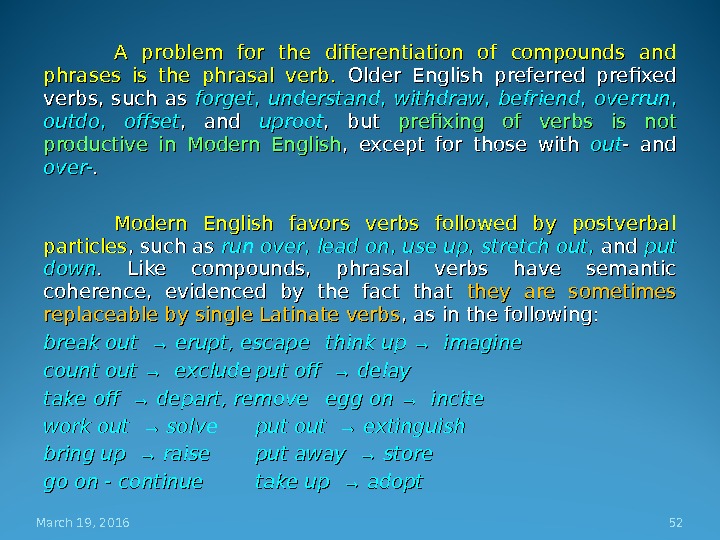
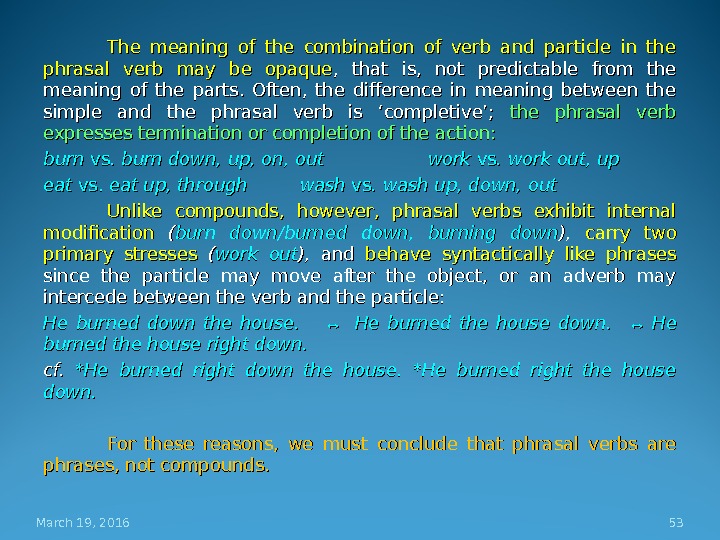

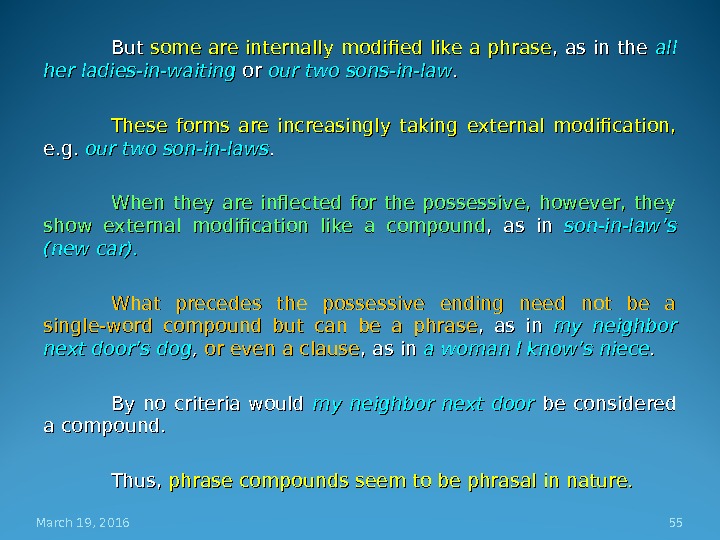


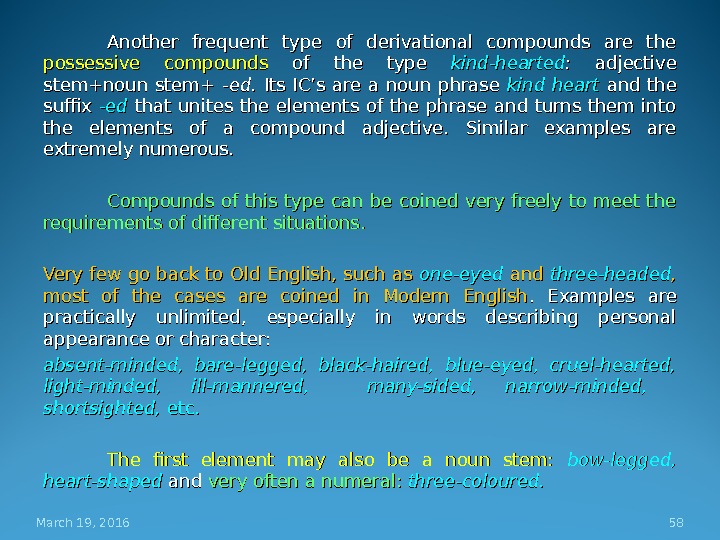





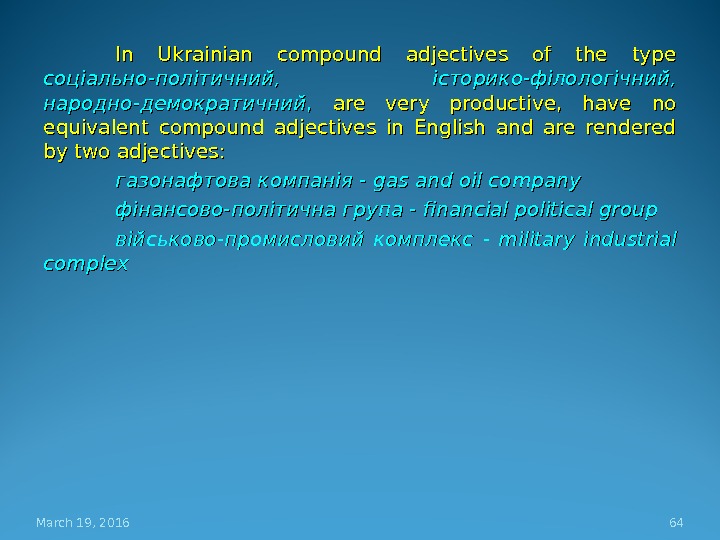



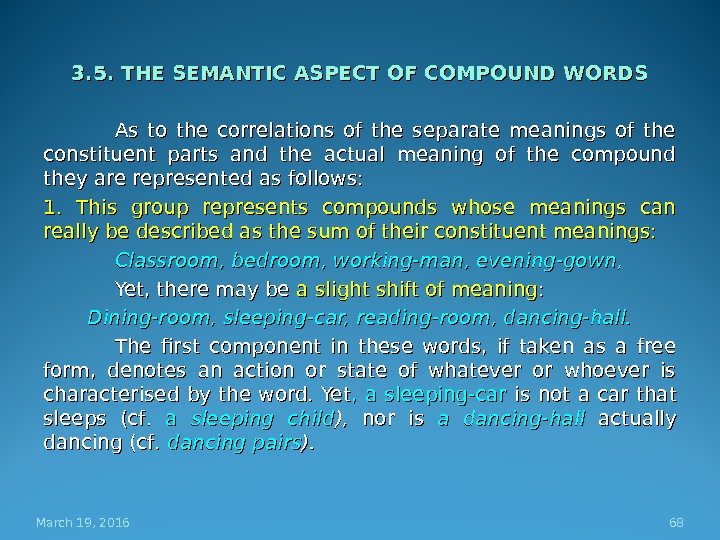



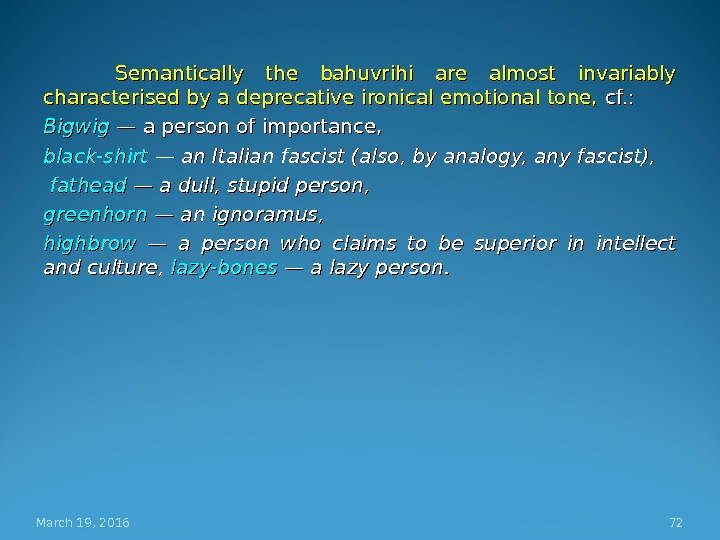




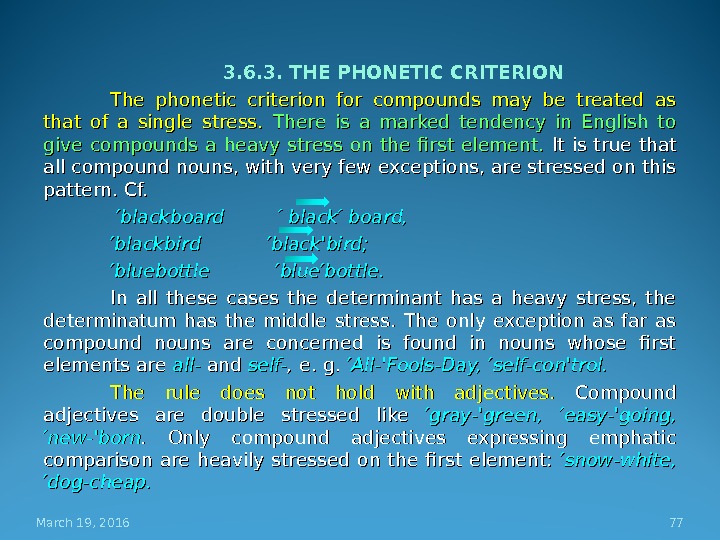
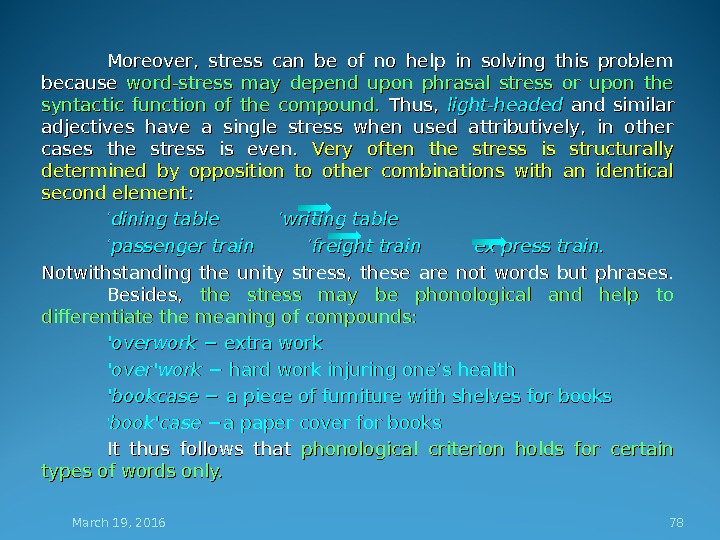

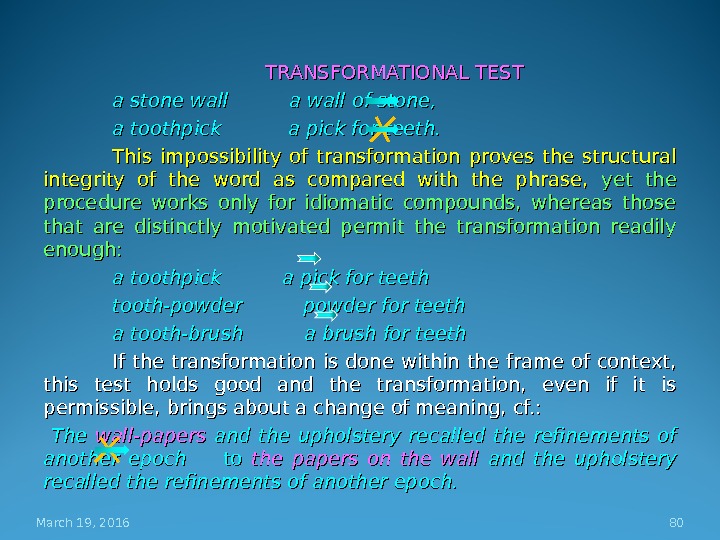
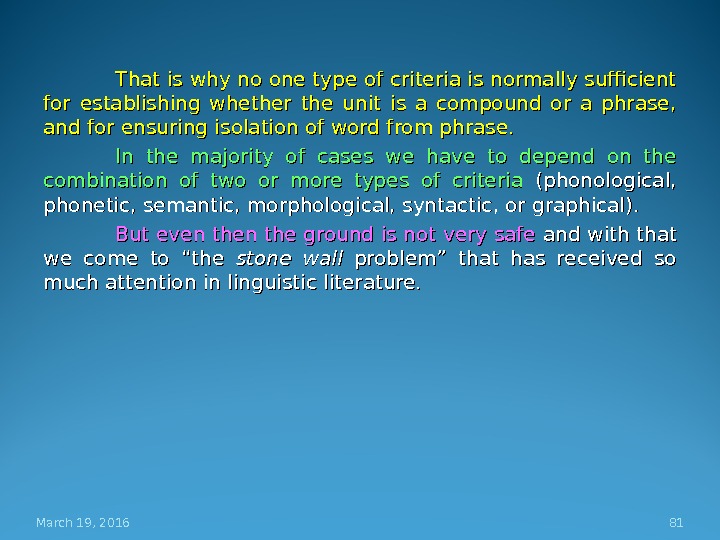
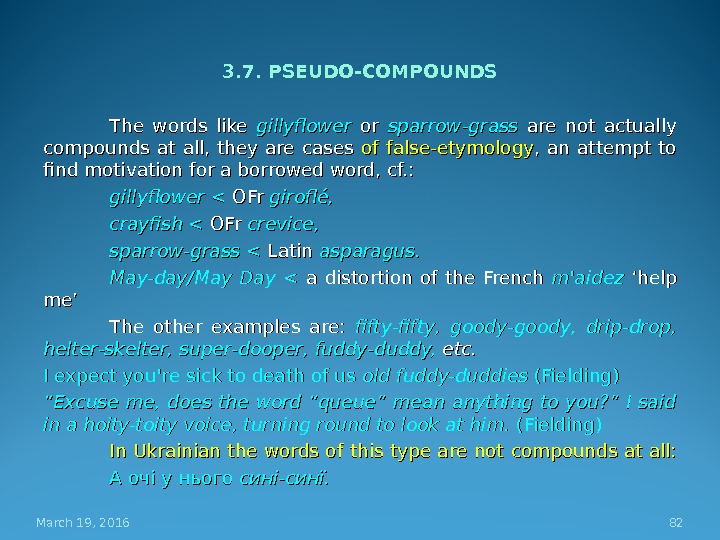
lecture_3._word-formation_in_modern_english.ppt
- Размер: 4.1 Mегабайта
- Количество слайдов: 82
Описание презентации Lecture 3 Word-formation in Modern English 1. по слайдам
 Lecture 3 Word-formation in Modern English 1. Productivity. Productive and non-productive ways of word-formation. 2. Derivation. 2. 1. Semantics of Affixes. 2. 2. Boundary cases between derivation, inflection and composition 2. 2. 1 Semi-Affixes. 2. 2. 2. Combining forms. 2. 3. Reduplication. 3. Compounds. 3. 1. Neutral Compounds 3. 3. Morphological compounds 3. 4 Syntactic compounds 3. 5. Specific features of English Compounding 3. 6. The criteria of compounds. 3. 7. Pseudo-compounds. March 19,
Lecture 3 Word-formation in Modern English 1. Productivity. Productive and non-productive ways of word-formation. 2. Derivation. 2. 1. Semantics of Affixes. 2. 2. Boundary cases between derivation, inflection and composition 2. 2. 1 Semi-Affixes. 2. 2. 2. Combining forms. 2. 3. Reduplication. 3. Compounds. 3. 1. Neutral Compounds 3. 3. Morphological compounds 3. 4 Syntactic compounds 3. 5. Specific features of English Compounding 3. 6. The criteria of compounds. 3. 7. Pseudo-compounds. March 19,
 1. PRODUCTIVITY. PRODUCTIVE AND NON-PRODUCTIVE WAYS OF WORD-FORMATION. Productivity is the ability to form new words after existing patterns which are readily understood by the speakers of a language. . Figure 1 , , March 19, 2016 2 The most productive ways of word-forma tion Abbreviation (contraction )) Conversion (( Functional Shift)Derivation (Affixation) Word-compositi onon
1. PRODUCTIVITY. PRODUCTIVE AND NON-PRODUCTIVE WAYS OF WORD-FORMATION. Productivity is the ability to form new words after existing patterns which are readily understood by the speakers of a language. . Figure 1 , , March 19, 2016 2 The most productive ways of word-forma tion Abbreviation (contraction )) Conversion (( Functional Shift)Derivation (Affixation) Word-compositi onon
 In the course of time the productivity of this or that way of word-formation may change. Sound interchange or or gradation (blood − to bleed, to abide − abode, to strike − stroke) was a productive way of word building in old English and is important for a diachronic study of the English language. It has lost its productivity in Modern English and no new word can be coined by means of sound gradation. Affixation on the contrary was productive in Old English and is still one of the most productive ways of word building in Modern English. March 19,
In the course of time the productivity of this or that way of word-formation may change. Sound interchange or or gradation (blood − to bleed, to abide − abode, to strike − stroke) was a productive way of word building in old English and is important for a diachronic study of the English language. It has lost its productivity in Modern English and no new word can be coined by means of sound gradation. Affixation on the contrary was productive in Old English and is still one of the most productive ways of word building in Modern English. March 19,
 2. DERIVATION The addition of a word-forming affix is called derivation. The process of affixation consists in coining a new word by adding an affix or several affixes to some root morpheme. Suffixation is more productive than prefixation. Suffixation is characteristic of noun and adjective formation, while prefixation is typical of verb formation (( incoming, trainee, principal, promotion ). ). Figure 2 March 19,
2. DERIVATION The addition of a word-forming affix is called derivation. The process of affixation consists in coining a new word by adding an affix or several affixes to some root morpheme. Suffixation is more productive than prefixation. Suffixation is characteristic of noun and adjective formation, while prefixation is typical of verb formation (( incoming, trainee, principal, promotion ). ). Figure 2 March 19,
 a phonological change: reduce >> reduction, clear >> clarity, fuse >> fusion, include >> inclusive, drama >> dramatize, relate >> relation, permit >> permissive, impress >> impression, electric >> electricity, photograph >> photography; an orthographic change to the root : : pity >> pitiful, deny >> denial, happy >> happiness; a semantic change : : husband >> husbandry, event >> even tual, post >> postage, recite >> recital, emerge >> emergency; a change in word class : : eateat (V) >> eatable (A), impress (V) >> impression (N). March 19,
a phonological change: reduce >> reduction, clear >> clarity, fuse >> fusion, include >> inclusive, drama >> dramatize, relate >> relation, permit >> permissive, impress >> impression, electric >> electricity, photograph >> photography; an orthographic change to the root : : pity >> pitiful, deny >> denial, happy >> happiness; a semantic change : : husband >> husbandry, event >> even tual, post >> postage, recite >> recital, emerge >> emergency; a change in word class : : eateat (V) >> eatable (A), impress (V) >> impression (N). March 19,
 In English, derivational affixes are either prefixes or suffixes. They may be native (deriving from Old English) or foreign (borrowed along with a word from a foreign language, especially French). Their productivity may range from very limited to quite extensive, depending upon whether they are preserved in just a few words and no longer used to create new words or whether they are found in many words and still used to create new words. An example of an unproductive suffix is the -th-th in in warmth, width, depth, or or wealth, whereas an example of a productive suffix is is the — able in in available, unthinkable, admirable , , or or honorable. Which affix attaches to which root is always quite arbitrary and unpredictable; it is not a matter of rule but must be stated separately for each root. March 19,
In English, derivational affixes are either prefixes or suffixes. They may be native (deriving from Old English) or foreign (borrowed along with a word from a foreign language, especially French). Their productivity may range from very limited to quite extensive, depending upon whether they are preserved in just a few words and no longer used to create new words or whether they are found in many words and still used to create new words. An example of an unproductive suffix is the -th-th in in warmth, width, depth, or or wealth, whereas an example of a productive suffix is is the — able in in available, unthinkable, admirable , , or or honorable. Which affix attaches to which root is always quite arbitrary and unpredictable; it is not a matter of rule but must be stated separately for each root. March 19,
 Derivation is part of the lexicon, not part of the grammar of a language. Only three prefixes, which are no longer productive in English, systematically change the part of speech of the root: а- а- N/V > A ablaze, asleep, astir, astride, abed, abroad be-be- N > V betoken, befriend, bedeck, becalm, besmirch en- A/N > V enlarge, ensure, encircle, encase, entrap Other prefixes change only the meaning of the root, not its class. March 19,
Derivation is part of the lexicon, not part of the grammar of a language. Only three prefixes, which are no longer productive in English, systematically change the part of speech of the root: а- а- N/V > A ablaze, asleep, astir, astride, abed, abroad be-be- N > V betoken, befriend, bedeck, becalm, besmirch en- A/N > V enlarge, ensure, encircle, encase, entrap Other prefixes change only the meaning of the root, not its class. March 19,
 March 19, 2016 8 Table 1. Semantic Classes of Prefixes in English Time Number Place Degree Privation Negation Size pre- prearrange, presuppose, preheat after — aftershock, afterthought, afterglow tri- tricycle, triannual, triconsonantal multi- multinational, multilingual, multimillionaire in- infield, in-patient, ingrown inter- interconnect, interbreed, interlace super- supersensitive, supersaturated, superheat over- overanxious, overconfident, overdue a- a- amoral, apolitical, asymmetric un- unlock, untie, unfold un-un- unafraid, unsafe, unwise anti- antisocial, antitrust, antiwar micro- microcosm, microchip, microfilm mini- miniskirt, minivan, minimal
March 19, 2016 8 Table 1. Semantic Classes of Prefixes in English Time Number Place Degree Privation Negation Size pre- prearrange, presuppose, preheat after — aftershock, afterthought, afterglow tri- tricycle, triannual, triconsonantal multi- multinational, multilingual, multimillionaire in- infield, in-patient, ingrown inter- interconnect, interbreed, interlace super- supersensitive, supersaturated, superheat over- overanxious, overconfident, overdue a- a- amoral, apolitical, asymmetric un- unlock, untie, unfold un-un- unafraid, unsafe, unwise anti- antisocial, antitrust, antiwar micro- microcosm, microchip, microfilm mini- miniskirt, minivan, minimal
 Many suffixes attached to nouns change their meaning but not their class: The diminutive suffixes -ling, -let, -y, -ie (as in in princeling, piglet, daddy, hoodie ), Diminution (e. g. doggy )) is not the only use for the diminutive suffix; it may also express degradation (e. g. dummy ), ), amelioration (e. g. hubby ), ), and intimacy (e. g. Jenny < Jennifer ). ). March 19, 2016 9 Functions of of Suffixes Figure
Many suffixes attached to nouns change their meaning but not their class: The diminutive suffixes -ling, -let, -y, -ie (as in in princeling, piglet, daddy, hoodie ), Diminution (e. g. doggy )) is not the only use for the diminutive suffix; it may also express degradation (e. g. dummy ), ), amelioration (e. g. hubby ), ), and intimacy (e. g. Jenny < Jennifer ). ). March 19, 2016 9 Functions of of Suffixes Figure
 the feminine suffixes — ess, — ette , -rix, -ine (as in actress, usherette, aviatrix, heroine ) − which, for social and cultural reasons, are now falling out of use, the abstract suffixes — ship, -hood, -ism , making abstract nouns out of concrete nouns (as in friendship, neighborhood, hoodlumism ), or suffixes denoting people such as -(i)an, -ist, -er (in(in librarian, Texan, Canadian, Marxist, Londoner ). ). Some suffixes attached to adjectives likewise change only their meaning: -ish means ‘nearly, not exactly’ in greenish, fortyish, coldish -ly-ly express ‘resemblance’ in goodly, sickly, lonely More often, however, suffixes change the word class of the root as shown in Table 2 March 19,
the feminine suffixes — ess, — ette , -rix, -ine (as in actress, usherette, aviatrix, heroine ) − which, for social and cultural reasons, are now falling out of use, the abstract suffixes — ship, -hood, -ism , making abstract nouns out of concrete nouns (as in friendship, neighborhood, hoodlumism ), or suffixes denoting people such as -(i)an, -ist, -er (in(in librarian, Texan, Canadian, Marxist, Londoner ). ). Some suffixes attached to adjectives likewise change only their meaning: -ish means ‘nearly, not exactly’ in greenish, fortyish, coldish -ly-ly express ‘resemblance’ in goodly, sickly, lonely More often, however, suffixes change the word class of the root as shown in Table 2 March 19,
 March 19, 2016 11 Table 2. Derivational Suffixes in English Nominalizer Verbalizer V > N A > N A/N > V -ment -er-er -(c)ation -al-al -ance/-ence -dom -ness -ity -ify -ize -ate -en-en arrangement, judgment, advancement worker, helper, leader legalization, simplification, taxation disposal, refusal, arrival, trial ignorance, performance, reference freedom, officialdom, Christendom happiness, cleverness, bitterness legality, purity, equality pacify, simplify, purify prioritize, publicize, centralize hyphenate, orchestrate, chlorinate lighten, soften, tighten, moisten
March 19, 2016 11 Table 2. Derivational Suffixes in English Nominalizer Verbalizer V > N A > N A/N > V -ment -er-er -(c)ation -al-al -ance/-ence -dom -ness -ity -ify -ize -ate -en-en arrangement, judgment, advancement worker, helper, leader legalization, simplification, taxation disposal, refusal, arrival, trial ignorance, performance, reference freedom, officialdom, Christendom happiness, cleverness, bitterness legality, purity, equality pacify, simplify, purify prioritize, publicize, centralize hyphenate, orchestrate, chlorinate lighten, soften, tighten, moisten
 March 19, 2016 12 Adjectivalizer Adverbializer N > A V > A A/N > Adv yy -ous -ful -ive -able -ful -ent/-ant -ward -ly-ly -way(s) flowery, thirsty, bloody poisonous, famous, glamorous delightful, sinful, pitiful supportive, generative, assertive acceptable, livable, changeable hopeful, thankful, useful absorbent, flippant, repellent homeward, eastward, downward quickly, terribly, gradually sideway(s), anyway(s), someway. Table 2. Derivational Suffixes in English (Continued)
March 19, 2016 12 Adjectivalizer Adverbializer N > A V > A A/N > Adv yy -ous -ful -ive -able -ful -ent/-ant -ward -ly-ly -way(s) flowery, thirsty, bloody poisonous, famous, glamorous delightful, sinful, pitiful supportive, generative, assertive acceptable, livable, changeable hopeful, thankful, useful absorbent, flippant, repellent homeward, eastward, downward quickly, terribly, gradually sideway(s), anyway(s), someway. Table 2. Derivational Suffixes in English (Continued)
 The false morphological division of words may result in more or less productive suffixes, which one scholar calls “splinters” , , as in the following: ham/burger > cheeseburger; fishburger; mushroomburger; vegieburger alc/oholic > workaholic; chocaholic; rageaholic mar/athon > workathon; telethon; swimathon; walkathon pano/rama > autorama ; motorama caval/cade > aquacade; motorcade heli/copter > heliport; helidrome; helistop March 19,
The false morphological division of words may result in more or less productive suffixes, which one scholar calls “splinters” , , as in the following: ham/burger > cheeseburger; fishburger; mushroomburger; vegieburger alc/oholic > workaholic; chocaholic; rageaholic mar/athon > workathon; telethon; swimathon; walkathon pano/rama > autorama ; motorama caval/cade > aquacade; motorcade heli/copter > heliport; helidrome; helistop March 19,
 Derivation can be stated in terms of lexical rules: mis- + + align (V) + -ment > > misalignment (N) image (N) + -ine + + -ary > > imaginary (A) false (A) + -ify > > falsify (V)(V) March 19,
Derivation can be stated in terms of lexical rules: mis- + + align (V) + -ment > > misalignment (N) image (N) + -ine + + -ary > > imaginary (A) false (A) + -ify > > falsify (V)(V) March 19,
 March 19, 2016 15 Figure 44 From the etymological point of view affixes are classified into the same two large groups as words: native and borrowed.
March 19, 2016 15 Figure 44 From the etymological point of view affixes are classified into the same two large groups as words: native and borrowed.
 If these conditions are fulfilled, the foreign affix may even become productive and combine with native stems or borrowed stems within the system of English vocabulary like -able < < Lat -abilis in such words as laughable or or unforgettable and unforgivable. . The English words balustrade , , brigade , , cascade are borrowed from French. On the analogy with these in the English language itself such words as blockade are coined. Affixes are usually divided into living and dead affixes. Living affixes are easily separated from the stem: care-ful ) ) Dead affixes have become fully merged with the stem and can be singled out by a diachronic analysis of the development of the word: admit < Lat. ad+mittere. . March 19,
If these conditions are fulfilled, the foreign affix may even become productive and combine with native stems or borrowed stems within the system of English vocabulary like -able < < Lat -abilis in such words as laughable or or unforgettable and unforgivable. . The English words balustrade , , brigade , , cascade are borrowed from French. On the analogy with these in the English language itself such words as blockade are coined. Affixes are usually divided into living and dead affixes. Living affixes are easily separated from the stem: care-ful ) ) Dead affixes have become fully merged with the stem and can be singled out by a diachronic analysis of the development of the word: admit < Lat. ad+mittere. . March 19,
 Affixes can also be classified into productive and non-productive types. By By productive affixes we mean the ones, which take part in deriving new words in this particular period of language development. The best way to identify productive affixes is to look for them among neologisms and so-called nonce-words (words coined and used only for this particular occasion). The latter are usually formed on the level of living speech and reflect the most productive and progressive patterns in word-building: unputdownable thrill ; ; ““ I I don’t like Sunday evenings: I feel so Mondayish”; Professor Pringle was a thinnish, baldish, dispeptic-lookingish cove with an eye like a haddock. March 19,
Affixes can also be classified into productive and non-productive types. By By productive affixes we mean the ones, which take part in deriving new words in this particular period of language development. The best way to identify productive affixes is to look for them among neologisms and so-called nonce-words (words coined and used only for this particular occasion). The latter are usually formed on the level of living speech and reflect the most productive and progressive patterns in word-building: unputdownable thrill ; ; ““ I I don’t like Sunday evenings: I feel so Mondayish”; Professor Pringle was a thinnish, baldish, dispeptic-lookingish cove with an eye like a haddock. March 19,
 In many cases the choice of the affixes is a means of differentiating meaning: uninterested − disinterested; distrust − mistrust. One should not confuse the productivity of affixes with their frequency of occurrence. There are quite a number of high-frequency affixes which, nevertheless, are no longer used in word-derivation, cf. : the adjective-forming native suffixes -ful, -ly; the adjective-forming suffixes of Latin origin -ant, -ent, -al-al Affixes are always bound forms. March 19,
In many cases the choice of the affixes is a means of differentiating meaning: uninterested − disinterested; distrust − mistrust. One should not confuse the productivity of affixes with their frequency of occurrence. There are quite a number of high-frequency affixes which, nevertheless, are no longer used in word-derivation, cf. : the adjective-forming native suffixes -ful, -ly; the adjective-forming suffixes of Latin origin -ant, -ent, -al-al Affixes are always bound forms. March 19,
 The difference between suffixes and prefixes is not confined to their respective position, suffixes being “fixed after” and prefixes “fixed before” the stem. It also concerns their function and meaning. A suffix is a derivational morpheme following the stem and forming a new derivative in a different part of speech or a different word class, сс f. : -en, -y, -less in in hearten, hearty, heartless. When both the underlying and the resultant forms belong to the same part of speech, the suffix serves to differentiate between lexico-grammatical classes by rendering some very general lexico-grammatical meaning, cf. : -ify (characterises causative verbs) horrify, purify, rarefy, simplify; -er ( is mostly typical of frequentative verbs) flicker, shimmer, twitter. . March 19,
The difference between suffixes and prefixes is not confined to their respective position, suffixes being “fixed after” and prefixes “fixed before” the stem. It also concerns their function and meaning. A suffix is a derivational morpheme following the stem and forming a new derivative in a different part of speech or a different word class, сс f. : -en, -y, -less in in hearten, hearty, heartless. When both the underlying and the resultant forms belong to the same part of speech, the suffix serves to differentiate between lexico-grammatical classes by rendering some very general lexico-grammatical meaning, cf. : -ify (characterises causative verbs) horrify, purify, rarefy, simplify; -er ( is mostly typical of frequentative verbs) flicker, shimmer, twitter. . March 19,
 A prefix is a derivational morpheme standing before the root and modifying meaning, cf. : hearten — — dishearten. It is only with verbs and statives that a prefix may serve to distinguish one part of speech from another, cf. : earth n n — — unearth v, v, sleep n n — — asleep (stative). Preceding a verb stem, some prefixes express the difference between a transitive and an intransitive verb: stay v v —— outstay (sb) vt. . With a few exceptions prefixes modify the stem for time (pre-, post-), place (in-, ad- ) ) oror negation (un-, dis-) and remain semantically rather independent of the stem. March 19,
A prefix is a derivational morpheme standing before the root and modifying meaning, cf. : hearten — — dishearten. It is only with verbs and statives that a prefix may serve to distinguish one part of speech from another, cf. : earth n n — — unearth v, v, sleep n n — — asleep (stative). Preceding a verb stem, some prefixes express the difference between a transitive and an intransitive verb: stay v v —— outstay (sb) vt. . With a few exceptions prefixes modify the stem for time (pre-, post-), place (in-, ad- ) ) oror negation (un-, dis-) and remain semantically rather independent of the stem. March 19,
 2. 1. SEMANTICS OF AFFIXES Meanings of affixes are specific and considerably differ from those of root morphemes. Affixes have widely generalised meanings and refer the concept conveyed by the whole word to a certain category, which is vast and all-embracing. Figure 5 March 19,
2. 1. SEMANTICS OF AFFIXES Meanings of affixes are specific and considerably differ from those of root morphemes. Affixes have widely generalised meanings and refer the concept conveyed by the whole word to a certain category, which is vast and all-embracing. Figure 5 March 19,
 Some words with this suffix have no equivalents in Ukrainian and may be rendered in descriptive way: The sheriff might have been a slow talker, but he was a fast mover (Irish). − − Можливо, шериф і говорив повільно, та рухався він швидко. I’m not a talker, boys, talking’s not what I do, but I want you to know that this is not. . . . (King). − − Я не дуже балакучий. . . Other noun-forming suffixes designating the same semantic field both in English and Ukrainian are given in table 3: 3: March 19,
Some words with this suffix have no equivalents in Ukrainian and may be rendered in descriptive way: The sheriff might have been a slow talker, but he was a fast mover (Irish). − − Можливо, шериф і говорив повільно, та рухався він швидко. I’m not a talker, boys, talking’s not what I do, but I want you to know that this is not. . . . (King). − − Я не дуже балакучий. . . Other noun-forming suffixes designating the same semantic field both in English and Ukrainian are given in table 3: 3: March 19,
 March 19, 2016 23 Noun-forming suffixes designating the same semantic field both in English and Ukrainian English Ukrainian -er teacher, banker, thinker, worker, miner, driver, dancer, reader, owner, leader, worker, robber, producer, owner, knower, observer, singer, programmer -ar/or liar, proprietor, vendor, ambassador, dictator -ant/-ent participant, claimant, student -ist philologist, scientist — ее detainee, employee -ess (feminine) actress, proprietress -ар шахтар, лікар -ір/-ир/-ер-/ор банкір, бригадир, офіцер, лідер, диктатор -тель вчитель, мислитель -ик/-ник робітник, виробник, радник, грабіжник, власник, передовик, відмінник -ій водій, тюхтій -ун брехун, товстун -ець підприємець, митець, знавець, українець -ач оглядач, попихач, позивач, читач -ак співак, мастак Table
March 19, 2016 23 Noun-forming suffixes designating the same semantic field both in English and Ukrainian English Ukrainian -er teacher, banker, thinker, worker, miner, driver, dancer, reader, owner, leader, worker, robber, producer, owner, knower, observer, singer, programmer -ar/or liar, proprietor, vendor, ambassador, dictator -ant/-ent participant, claimant, student -ist philologist, scientist — ее detainee, employee -ess (feminine) actress, proprietress -ар шахтар, лікар -ір/-ир/-ер-/ор банкір, бригадир, офіцер, лідер, диктатор -тель вчитель, мислитель -ик/-ник робітник, виробник, радник, грабіжник, власник, передовик, відмінник -ій водій, тюхтій -ун брехун, товстун -ець підприємець, митець, знавець, українець -ач оглядач, попихач, позивач, читач -ак співак, мастак Table
 March 19, 2016 24 noun-forming suffixes designating the same semantic field both in English and Ukrainian English Ukrainian -an/-ian vegeterian, politician, Mancunian -ette (fem) usherette, suffragette -ite laborite, Moscovite -іст машиніст, програміст — ант/ент практикант, дилетант, студент, кореспондент -ака писака, зівака -ан критикан -ло брехло, вайло -нь учень, злидень, здоровань -ша лівша -ля; -еса; -ка; -иця поетеса, актриса, праля, ткаля, практикантка, провідниця -ин молдаванин, грузин -як сибіряк, свояк -ит одесит, сибарит, бандит Table 3 (Continued)
March 19, 2016 24 noun-forming suffixes designating the same semantic field both in English and Ukrainian English Ukrainian -an/-ian vegeterian, politician, Mancunian -ette (fem) usherette, suffragette -ite laborite, Moscovite -іст машиніст, програміст — ант/ент практикант, дилетант, студент, кореспондент -ака писака, зівака -ан критикан -ло брехло, вайло -нь учень, злидень, здоровань -ша лівша -ля; -еса; -ка; -иця поетеса, актриса, праля, ткаля, практикантка, провідниця -ин молдаванин, грузин -як сибіряк, свояк -ит одесит, сибарит, бандит Table 3 (Continued)
 March 19, 2016 25 The correlation of the other noun-forming suffixes in English and Ukrainian English Ukrainian -ion explanation, probation, rotation, explosion — ment unemployment, movement, appointment, enjoyment — ance/-ence experience, reassurance, entrance -ancyl-ency valency, insolvency, pregnancy -ness happiness, willingness, tenderness, kindness -ism cynicism, criticism -th breadth, width -dom freedom, officialdom, kingdom -ship friendship, statesmanship -hood childhood, likelihood -ing unbuilding, painting -ота доброта, скорбота, біднота -ина ширина, довжина -їсть бідність, убогість, більшість, вагітність -ство товариство, малярство, правознавство, дитинство -ання/-ення призначення, сьогодення, світання, пояснення -изм/ізм шовінізм, расизм -ція ерудиція, апробація, агітація, симуляція -(іт)тя безробіття, лихоліття, майбуття, шмаття Table
March 19, 2016 25 The correlation of the other noun-forming suffixes in English and Ukrainian English Ukrainian -ion explanation, probation, rotation, explosion — ment unemployment, movement, appointment, enjoyment — ance/-ence experience, reassurance, entrance -ancyl-ency valency, insolvency, pregnancy -ness happiness, willingness, tenderness, kindness -ism cynicism, criticism -th breadth, width -dom freedom, officialdom, kingdom -ship friendship, statesmanship -hood childhood, likelihood -ing unbuilding, painting -ота доброта, скорбота, біднота -ина ширина, довжина -їсть бідність, убогість, більшість, вагітність -ство товариство, малярство, правознавство, дитинство -ання/-ення призначення, сьогодення, світання, пояснення -изм/ізм шовінізм, расизм -ція ерудиція, апробація, агітація, симуляція -(іт)тя безробіття, лихоліття, майбуття, шмаття Table
 2. 2. BOUNDARY CASES BETWEEN DERIVATION, INFLECTION AND COMPOSITION 2. 2. 1 SEMI-AFFIXES There are a few roots in English which have developed great combining ability in the position of the second element of a word and a very general meaning similar to that of an affix. These are semi-affixes − semantically, functionally, structurally and statistically they behave more like affixes than like roots. Their meaning is as general. They determine the lexical and grammatical class the word belongs to, cc f. : sailor ↔ ↔ seaman, -or is a suffix, -man is a semi-affix: sportsman, gentleman, nobleman, salesman, seaman, fisherman, countryman, statesman, policeman. March 19,
2. 2. BOUNDARY CASES BETWEEN DERIVATION, INFLECTION AND COMPOSITION 2. 2. 1 SEMI-AFFIXES There are a few roots in English which have developed great combining ability in the position of the second element of a word and a very general meaning similar to that of an affix. These are semi-affixes − semantically, functionally, structurally and statistically they behave more like affixes than like roots. Their meaning is as general. They determine the lexical and grammatical class the word belongs to, cc f. : sailor ↔ ↔ seaman, -or is a suffix, -man is a semi-affix: sportsman, gentleman, nobleman, salesman, seaman, fisherman, countryman, statesman, policeman. March 19,
 Semantically, the constituent -man in these words approaches the generalised meaning of such noun-forming suffixes as as -er, -or, -ist ( ( artist), -ite (( hypocrite). Other examples of semi-affixes are: -land Ireland, Scotland, fatherland, wonderland -like ladylike, unladylike, businesslike, starlike, flowerlike, -worthy seaworthy, trustworthy, praiseworthy. The component -proof, standing between a stem and an affix, is regarded by some scholars as a semi-affix: ““. . . The Great Glass Elevator is shockproof , , waterproof, bombproof and bulletproof. . . ” Lady Malvern tried to freeze him with a look, but you can’t do that sort of thing to Jeeves. He is look-proof. Better sorts of lip-stick are frequently described in advertisements as kissproof. Some building materials may be advertised as fireproof. Certain technical devices are foolproof meaning that they are safe even in a fool’s hands. March 19,
Semantically, the constituent -man in these words approaches the generalised meaning of such noun-forming suffixes as as -er, -or, -ist ( ( artist), -ite (( hypocrite). Other examples of semi-affixes are: -land Ireland, Scotland, fatherland, wonderland -like ladylike, unladylike, businesslike, starlike, flowerlike, -worthy seaworthy, trustworthy, praiseworthy. The component -proof, standing between a stem and an affix, is regarded by some scholars as a semi-affix: ““. . . The Great Glass Elevator is shockproof , , waterproof, bombproof and bulletproof. . . ” Lady Malvern tried to freeze him with a look, but you can’t do that sort of thing to Jeeves. He is look-proof. Better sorts of lip-stick are frequently described in advertisements as kissproof. Some building materials may be advertised as fireproof. Certain technical devices are foolproof meaning that they are safe even in a fool’s hands. March 19,
 All these words, with -proof for the second component, stand between compounds and derived words in their characteristics. On the one hand, the second component seems to bear all the features of a stem and preserves certain semantic associations with the free form proof. . On the other hand, the meaning of — proof in all the numerous words built on this pattern has become so generalised that it is certainly approaching that of a suffix. The high productivity of the pattern is proved, once more, by the possibility of coining nonce-words after this pattern: look-proof. Semi-affixes may be also used in preposition like prefixes. Thus, anything that is smaller or shorter than others of its kind may be preceded by by mini-: mini-budget, mini-bus, mini-car, mini-crisis, mini-planet, mini-skirt, etc. Other productive semi-affixes used in pre-position are midi- , , maxi-, self- and others: midi-coat, maxi-coat, self-starter, self-help. March 19,
All these words, with -proof for the second component, stand between compounds and derived words in their characteristics. On the one hand, the second component seems to bear all the features of a stem and preserves certain semantic associations with the free form proof. . On the other hand, the meaning of — proof in all the numerous words built on this pattern has become so generalised that it is certainly approaching that of a suffix. The high productivity of the pattern is proved, once more, by the possibility of coining nonce-words after this pattern: look-proof. Semi-affixes may be also used in preposition like prefixes. Thus, anything that is smaller or shorter than others of its kind may be preceded by by mini-: mini-budget, mini-bus, mini-car, mini-crisis, mini-planet, mini-skirt, etc. Other productive semi-affixes used in pre-position are midi- , , maxi-, self- and others: midi-coat, maxi-coat, self-starter, self-help. March 19,
 In Ukrainian the following ss emi-affixes are used: повно- ново- само- авто- повноправний, новостворений, самохідний, автобіографія -вод, -воз діловод, тепловоз. . Figure 6. . March 19,
In Ukrainian the following ss emi-affixes are used: повно- ново- само- авто- повноправний, новостворений, самохідний, автобіографія -вод, -воз діловод, тепловоз. . Figure 6. . March 19,
 2. 2. 2. COMBINING FORMS An affix should not be confused with a combining form. Combining forms are linguistic forms which in modern languages are used as bound forms although in Greek and Latin from which they are borrowed they functioned as independent words. They constitute a specific type of linguistic units. Combining forms are mostly international. Descriptively a combining form differs from an affix, because it can occur as one constituent of a form whose only other constituent is an affix, cf. : graphic, cyclic. Affixes are characterised either by preposition with respect to the root (prefixes) or by postposition (suffixes), whereas the same combining form may occur in both positions, cc f. : phonograph, phonology and telephone, microphone, etcetc March 19,
2. 2. 2. COMBINING FORMS An affix should not be confused with a combining form. Combining forms are linguistic forms which in modern languages are used as bound forms although in Greek and Latin from which they are borrowed they functioned as independent words. They constitute a specific type of linguistic units. Combining forms are mostly international. Descriptively a combining form differs from an affix, because it can occur as one constituent of a form whose only other constituent is an affix, cf. : graphic, cyclic. Affixes are characterised either by preposition with respect to the root (prefixes) or by postposition (suffixes), whereas the same combining form may occur in both positions, cc f. : phonograph, phonology and telephone, microphone, etcetc March 19,
 Combining forms differ from all other borrowings in that they occur in compounds and derivatives that did not exist in their original language but were formed only in modern times in English, Russian, French, etc. , сс f. : polyclinic, polymer; stereophonic, stereoscopic, telemechanics, television. Combining forms are particularly frequent in the specialised vocabularies of arts and sciences. They have long become familiar in the international scientific terminology. Many of them attain widespread currency in everyday language: astron − star → astronomy; autos − self → automatic; bios − life → biology; electron − amber → electronics; ge − earth → geology; graph − to write → typography; hydor − water → hydroelectric; logos − speech → physiology; philein − love → philology phone − sound, voice → telephone; March 19,
Combining forms differ from all other borrowings in that they occur in compounds and derivatives that did not exist in their original language but were formed only in modern times in English, Russian, French, etc. , сс f. : polyclinic, polymer; stereophonic, stereoscopic, telemechanics, television. Combining forms are particularly frequent in the specialised vocabularies of arts and sciences. They have long become familiar in the international scientific terminology. Many of them attain widespread currency in everyday language: astron − star → astronomy; autos − self → automatic; bios − life → biology; electron − amber → electronics; ge − earth → geology; graph − to write → typography; hydor − water → hydroelectric; logos − speech → physiology; philein − love → philology phone − sound, voice → telephone; March 19,
 Combining forms mostly occur together with other combining forms and not with native roots. Almost all of the above examples are international words, each entering a considerable word-family: autobiography, autodiagnosis, automobile, autonomy, autogenic, autopilot, autoloader; bio-astronautics, biochemistry, bio-ecology, bionics, biophysics; economics, economist, economise, eco-climate, eco-activist, eco-type, eco-catastrophe; geodesy, geometry, geography; hydrodynamic, hydromechanic, hydroponic, hydrotherapeutic. hydrography, phonograph, photograph, telegraph. lexicology, philology, phonology. March 19,
Combining forms mostly occur together with other combining forms and not with native roots. Almost all of the above examples are international words, each entering a considerable word-family: autobiography, autodiagnosis, automobile, autonomy, autogenic, autopilot, autoloader; bio-astronautics, biochemistry, bio-ecology, bionics, biophysics; economics, economist, economise, eco-climate, eco-activist, eco-type, eco-catastrophe; geodesy, geometry, geography; hydrodynamic, hydromechanic, hydroponic, hydrotherapeutic. hydrography, phonograph, photograph, telegraph. lexicology, philology, phonology. March 19,
 2. 3 Reduplication is a process similar to derivation, in in which the initial syllable or the entire word is doubled, exactly or with a slight phonological change. Reduplication is not a common or regular process of word formation in English , though it may be in other languages. In English reduplication is often used in children’s language (e. g. boo-boo, putt-putt, choo-choo )) or for humorous or ironic effect (e. g. goody-goody, rah-rah, pooh-pooh ). ). March 19,
2. 3 Reduplication is a process similar to derivation, in in which the initial syllable or the entire word is doubled, exactly or with a slight phonological change. Reduplication is not a common or regular process of word formation in English , though it may be in other languages. In English reduplication is often used in children’s language (e. g. boo-boo, putt-putt, choo-choo )) or for humorous or ironic effect (e. g. goody-goody, rah-rah, pooh-pooh ). ). March 19,
 March 19, 2016 34 Exact reduplication papa, mama, goody-goody, so-so, hush-hush, never-never, tutu, fifty-fifty, hush-hush Ablaut reduplication criss-cross, zig-zag, flip-flop, mish-mash, wishy-washy, clip-clop, riff-raff, achy-breaky Rhyme reduplication hodge-podge , , fuddy-duddy , , razzle-dazzle , , boogie-woogie , , nitty-gritty , , roly-poly, hob-nob, hocus-pocus Figure 7 Reduplication
March 19, 2016 34 Exact reduplication papa, mama, goody-goody, so-so, hush-hush, never-never, tutu, fifty-fifty, hush-hush Ablaut reduplication criss-cross, zig-zag, flip-flop, mish-mash, wishy-washy, clip-clop, riff-raff, achy-breaky Rhyme reduplication hodge-podge , , fuddy-duddy , , razzle-dazzle , , boogie-woogie , , nitty-gritty , , roly-poly, hob-nob, hocus-pocus Figure 7 Reduplication
 Reduplications can be formed with two meaningful parts: flower-power , , brain drain, culture vulture, boy toy, heart smart. Reduplication has many different functions. it can express: 1) 1) disparagement (( namby- pamby ), ), 2) 2) intensification (( super-duper ), ), diminution (( teeny-weeny ), ), 3) 3) onomatopoeia (( tick- tock ), ), or alternation (( ping-pong ), ), among other uses. Reduplication is greatly facilitated in Modern English by the vast number of monosyllables. March 19,
Reduplications can be formed with two meaningful parts: flower-power , , brain drain, culture vulture, boy toy, heart smart. Reduplication has many different functions. it can express: 1) 1) disparagement (( namby- pamby ), ), 2) 2) intensification (( super-duper ), ), diminution (( teeny-weeny ), ), 3) 3) onomatopoeia (( tick- tock ), ), or alternation (( ping-pong ), ), among other uses. Reduplication is greatly facilitated in Modern English by the vast number of monosyllables. March 19,
 Stylistically speaking, most words made by reduplication represent informal groups: colloquialisms and slang: walkie-talkie − − a portable radio; riff-raff − − the worthless or disreputable element of society; chi-chi − sl. for chic as in a a chi-chi girl. . In a modern novel an angry father accuses his teenager son of doing nothing but dilly-dallying all over the town. . (( dilly-dallying — — wasting time, doing nothing, loitering) Another example of a word made by reduplication may be found in the following quotation from The Importance of Being Earnest by O. Wilde: I think it is high time that Mr. Bunbury made up his mind whether he was going to live or to die. This shilly-shallying with the question is absurd. (( shilly-shallying — — irresolution, indecision) March 19,
Stylistically speaking, most words made by reduplication represent informal groups: colloquialisms and slang: walkie-talkie − − a portable radio; riff-raff − − the worthless or disreputable element of society; chi-chi − sl. for chic as in a a chi-chi girl. . In a modern novel an angry father accuses his teenager son of doing nothing but dilly-dallying all over the town. . (( dilly-dallying — — wasting time, doing nothing, loitering) Another example of a word made by reduplication may be found in the following quotation from The Importance of Being Earnest by O. Wilde: I think it is high time that Mr. Bunbury made up his mind whether he was going to live or to die. This shilly-shallying with the question is absurd. (( shilly-shallying — — irresolution, indecision) March 19,
 3. COMPOUNDS A compound is the combination of two or more free roots (plus associated affixes). The bulk of compound words is motivated and the semantic relations between the two components are transparent. The great variety of compound types brings about a great variety of classifications (see Figure 7). March 19,
3. COMPOUNDS A compound is the combination of two or more free roots (plus associated affixes). The bulk of compound words is motivated and the semantic relations between the two components are transparent. The great variety of compound types brings about a great variety of classifications (see Figure 7). March 19,
 March 19, 2016 38 Figure
March 19, 2016 38 Figure
 Eendocentric: Eng. beetroot, iceice — cold , , knee — deep, babysit, whitewash; UAUA. . землеустрій, сівозміна, літакобудування ; ; Exocentric: Eng. . scarecrow — — something that scares crows; UAUA гуртожиток, склоріз, самопал ; ; BB ahuvrihi: Eng. . lazy — bones , , fathead , , bonehead , , readcoat ; UAUA. . шибайголова, одчайдух, жовтобрюх ; ; SS yntactic and asyntactic combinations: Which of those fellows do you like to command a search-and-destroy mission? ; ““ Now come along, Bridget. I don’t want any silliness”, she said in her Genghis-Khan-at-height-of-evil voice; Kurtz caught sight of Permutter’s sunken , I-fooled-you grin in the wide rearview mirror. . March 19,
Eendocentric: Eng. beetroot, iceice — cold , , knee — deep, babysit, whitewash; UAUA. . землеустрій, сівозміна, літакобудування ; ; Exocentric: Eng. . scarecrow — — something that scares crows; UAUA гуртожиток, склоріз, самопал ; ; BB ahuvrihi: Eng. . lazy — bones , , fathead , , bonehead , , readcoat ; UAUA. . шибайголова, одчайдух, жовтобрюх ; ; SS yntactic and asyntactic combinations: Which of those fellows do you like to command a search-and-destroy mission? ; ““ Now come along, Bridget. I don’t want any silliness”, she said in her Genghis-Khan-at-height-of-evil voice; Kurtz caught sight of Permutter’s sunken , I-fooled-you grin in the wide rearview mirror. . March 19,
 The classification according to the type of composition establishes the following groups: 1) The predominant type is a mere juxtaposition without connecting elements: heartache n, n, heart-beat n, n, heart-breaking adj, heart-broken adj, heart-felt adj. 2) 2) Composition with a vowel or a consonant as a linking element. The examples are very few: electromotive adj, speedometer n, n, Afro-Asian adj, handicraft n, n, statesman n. n. 3) 3) Compounds with linking elements represented by preposition or conjunction stems : : down-and-out n, n, matter-of-fact adj, son-in-law n, n, pepper-and-salt adj, wall-to-wall adj, up-to-date adj, on the up-and-up adv, up-and-coming. March 19,
The classification according to the type of composition establishes the following groups: 1) The predominant type is a mere juxtaposition without connecting elements: heartache n, n, heart-beat n, n, heart-breaking adj, heart-broken adj, heart-felt adj. 2) 2) Composition with a vowel or a consonant as a linking element. The examples are very few: electromotive adj, speedometer n, n, Afro-Asian adj, handicraft n, n, statesman n. n. 3) 3) Compounds with linking elements represented by preposition or conjunction stems : : down-and-out n, n, matter-of-fact adj, son-in-law n, n, pepper-and-salt adj, wall-to-wall adj, up-to-date adj, on the up-and-up adv, up-and-coming. March 19,
 The classification of compounds according to the structure of immediate constituents distinguishes: 1) 1) compounds consisting of simple stems: film-star. Compounds formed by joining together stems of words already available in the language and the two ICs of which are stems of notional words are also called compounds proper: Eng. ice-cold (N+A) , , ill-luck (A+N); UA UA диван-ліжко, матч-реванш, лікар-терапевт. . 2) 2) compounds where at least one of the constituents is a derived stem: chain-smoker; 3) 3) compounds where at least one of the constituents is a clipped stem: maths-mistress (in British English) math-mistress (in American English). The subgroup will contain abbreviations like H-bag (handbag) or or Xmas (Christmas), whodunit n (for mystery novels ); ); March 19,
The classification of compounds according to the structure of immediate constituents distinguishes: 1) 1) compounds consisting of simple stems: film-star. Compounds formed by joining together stems of words already available in the language and the two ICs of which are stems of notional words are also called compounds proper: Eng. ice-cold (N+A) , , ill-luck (A+N); UA UA диван-ліжко, матч-реванш, лікар-терапевт. . 2) 2) compounds where at least one of the constituents is a derived stem: chain-smoker; 3) 3) compounds where at least one of the constituents is a clipped stem: maths-mistress (in British English) math-mistress (in American English). The subgroup will contain abbreviations like H-bag (handbag) or or Xmas (Christmas), whodunit n (for mystery novels ); ); March 19,
 4) compounds where at least one of the constituents is a compound stem: wastepaper-basket. In coordinative compounds neither of the components dominates the other, both are structurally and semantically independent and constitute two structural and semantic centres, cf. : breath-taking, self-discipline, word-formaiton. Compounds are not homogeneous in structure. Traditionally three types are distinguished: neutral, morphological andand syntactic. . In In neutral compounds the process of compounding is realised without any linking elements, by a mere juxtaposition of two stems: blackbird, shop-window, sunflower, bedroom, tallboy, etc. There are three subtypes of neutral compounds depending on the structure of the constituent stems. The examples above represent the subtype which may be described as simple neutral compounds: they consist of simple affixless stems. March 19,
4) compounds where at least one of the constituents is a compound stem: wastepaper-basket. In coordinative compounds neither of the components dominates the other, both are structurally and semantically independent and constitute two structural and semantic centres, cf. : breath-taking, self-discipline, word-formaiton. Compounds are not homogeneous in structure. Traditionally three types are distinguished: neutral, morphological andand syntactic. . In In neutral compounds the process of compounding is realised without any linking elements, by a mere juxtaposition of two stems: blackbird, shop-window, sunflower, bedroom, tallboy, etc. There are three subtypes of neutral compounds depending on the structure of the constituent stems. The examples above represent the subtype which may be described as simple neutral compounds: they consist of simple affixless stems. March 19,
 The productivity of derived or derivational compounds (compound-derivatives) is confirmed by a considerable number of comparatively recent formations, cf. : teenager, babysitter, strap-hanger, fourseater (car or boat with four seats), doubledecker (a ship or bus with two decks). Numerous nonce-words are coined on this pattern which is another proof of its high productivity: luncher-out (a person who habitually takes his lunch in restaurants and not at home), goose-flesher (murder story). In the coining of the derivational compounds two types of word-formation are at work. The essence of the derivational compounds will be clear if we compare them with derivatives and compounds proper that possess a similar structure. March 19,
The productivity of derived or derivational compounds (compound-derivatives) is confirmed by a considerable number of comparatively recent formations, cf. : teenager, babysitter, strap-hanger, fourseater (car or boat with four seats), doubledecker (a ship or bus with two decks). Numerous nonce-words are coined on this pattern which is another proof of its high productivity: luncher-out (a person who habitually takes his lunch in restaurants and not at home), goose-flesher (murder story). In the coining of the derivational compounds two types of word-formation are at work. The essence of the derivational compounds will be clear if we compare them with derivatives and compounds proper that possess a similar structure. March 19,
 brainstraster, honeymooner UC’s = noun stem + + noun stem+ -er-er. . mill-ownermill-owner IC’s = two noun stems mill+owner (Composition) honeymooner IC’s = mooner does not exist as a free stem IC’s = honeymoon + er (honey ++ moon)+-er (Derivation: honeymoon a compound honeymooner a a derivative) brains trust ( a phrase) brainstruster == c c omposition +derivation = a derivational compound IC’s = (brains+ trust) +-+- ее rr. . March 19,
brainstraster, honeymooner UC’s = noun stem + + noun stem+ -er-er. . mill-ownermill-owner IC’s = two noun stems mill+owner (Composition) honeymooner IC’s = mooner does not exist as a free stem IC’s = honeymoon + er (honey ++ moon)+-er (Derivation: honeymoon a compound honeymooner a a derivative) brains trust ( a phrase) brainstruster == c c omposition +derivation = a derivational compound IC’s = (brains+ trust) +-+- ее rr. . March 19,
 Another frequent type of derivational compounds are the possessive compounds of the type kind-hearted : : adjective stem+noun stem+ -ed. kind-hearted IC’s = a noun phrase kind heart + -ed The first element may also be a noun stem or a numeral: bow-legged, heart-shaped, three-coloured. The derivational compounds often become the basis of further derivation, cc f. : war-minded → → war-mindedness; whole-hearted → → whole-heartedness → → whole-heartedly, schoolboyish → → schoolboyishness; do-it-yourselfer → → do-it-yourselfism. The process is also called phrasal derivation: mini-skirt → → mini-skirted, nothing but → → nothingbutism, oo r r quotation derivation as when an unwillingness to do anything is characterised as let-George-do-it-ity. All these are nonce-words , with some ironic or jocular connotation. March 19,
Another frequent type of derivational compounds are the possessive compounds of the type kind-hearted : : adjective stem+noun stem+ -ed. kind-hearted IC’s = a noun phrase kind heart + -ed The first element may also be a noun stem or a numeral: bow-legged, heart-shaped, three-coloured. The derivational compounds often become the basis of further derivation, cc f. : war-minded → → war-mindedness; whole-hearted → → whole-heartedness → → whole-heartedly, schoolboyish → → schoolboyishness; do-it-yourselfer → → do-it-yourselfism. The process is also called phrasal derivation: mini-skirt → → mini-skirted, nothing but → → nothingbutism, oo r r quotation derivation as when an unwillingness to do anything is characterised as let-George-do-it-ity. All these are nonce-words , with some ironic or jocular connotation. March 19,
 « Morphological compounds, words in which two compounding stems are combined by a linking vowel or consonant are few in number. This type is non-productive: Anglo-Saxon, Franko-Prussian, handiwork, handicraft, craftsmanship, spokesman, statesman. . Syntactic compounds (the term is arbitrary) are formed from segments of speech, preserving in their structure numerous traces of syntagmatic relations typical of speech: articles, prepositions, adverbs , cf. : lily-of-the-valley, Jack-of-all-trades, good-for-nothing, mother-in-law, sit-at-home. March 19,
« Morphological compounds, words in which two compounding stems are combined by a linking vowel or consonant are few in number. This type is non-productive: Anglo-Saxon, Franko-Prussian, handiwork, handicraft, craftsmanship, spokesman, statesman. . Syntactic compounds (the term is arbitrary) are formed from segments of speech, preserving in their structure numerous traces of syntagmatic relations typical of speech: articles, prepositions, adverbs , cf. : lily-of-the-valley, Jack-of-all-trades, good-for-nothing, mother-in-law, sit-at-home. March 19,
 Both the semantics and the syntax of compound are complex. Often the semantics of compounds are not simply a sum of the meaning of the parts, that is, if we know the meaning of the two roots, we cannot necessarily predict the meaning of the compound, as in firearm , , highball, makeup, or handout. . Note the various ways in which the meanings of the roots of these compounds interact with home : : homeland ‘land which is one’s home’ homemade ‘something which is made at home’ homebody ‘someone who stays at home’ homestead ‘a place which is a home’ homework ‘work which is done at home’ homerun ‘a run to home’ homemaker ‘a person who makes (cares for) the home’ March 19,
Both the semantics and the syntax of compound are complex. Often the semantics of compounds are not simply a sum of the meaning of the parts, that is, if we know the meaning of the two roots, we cannot necessarily predict the meaning of the compound, as in firearm , , highball, makeup, or handout. . Note the various ways in which the meanings of the roots of these compounds interact with home : : homeland ‘land which is one’s home’ homemade ‘something which is made at home’ homebody ‘someone who stays at home’ homestead ‘a place which is a home’ homework ‘work which is done at home’ homerun ‘a run to home’ homemaker ‘a person who makes (cares for) the home’ March 19,
 The syntax of compounds is even more complex. Any combination of parts of speech seems possible, with almost any part of speech resulting. One principle which holds is that the word class of the compound is determined by the head of the compound, or its rightmost member, whereas the leftmost member carries the primary stress. . The only exception to this rule is a converted compound or one containing a class changing suffix. Look at the syntactic patterns of compounding shown in Table 5. March 19,
The syntax of compounds is even more complex. Any combination of parts of speech seems possible, with almost any part of speech resulting. One principle which holds is that the word class of the compound is determined by the head of the compound, or its rightmost member, whereas the leftmost member carries the primary stress. . The only exception to this rule is a converted compound or one containing a class changing suffix. Look at the syntactic patterns of compounding shown in Table 5. March 19,
 March 19, 2016 49 Table 5. Syntactic Patterns in English Compounds Compound Nouns N + N > N V + N > N A + N > N Prt + V > N V + Prt > N N + V > N N + -’s + N > NN V + -ing + N > N> N N + V + ing > NN N + V + -er > NN airplane, lipstick, gold-mine, deathblow, figurehead, cut-throat, pickpocket, spoil-sport, leapfrog, drawbridge madman, blackbird, fast-food, software, hotbed, mainland background, in-crowd, off-Broadway, afternoon outcast, downpour, outbreak, offspring put-down, drop-out, lockout, sit-in, fallout, runaway bloodshed, fleabite, bus-stand, sunrise, handshake, nosebleed bachelor’s degree, bull’s eye, cow’s milk, housemaid’s knee mocking bird, spending money, closing time, freezing point handwriting, housekeeping, foxhunting hairdresser, nutcracker, landowner, peacemaker
March 19, 2016 49 Table 5. Syntactic Patterns in English Compounds Compound Nouns N + N > N V + N > N A + N > N Prt + V > N V + Prt > N N + V > N N + -’s + N > NN V + -ing + N > N> N N + V + ing > NN N + V + -er > NN airplane, lipstick, gold-mine, deathblow, figurehead, cut-throat, pickpocket, spoil-sport, leapfrog, drawbridge madman, blackbird, fast-food, software, hotbed, mainland background, in-crowd, off-Broadway, afternoon outcast, downpour, outbreak, offspring put-down, drop-out, lockout, sit-in, fallout, runaway bloodshed, fleabite, bus-stand, sunrise, handshake, nosebleed bachelor’s degree, bull’s eye, cow’s milk, housemaid’s knee mocking bird, spending money, closing time, freezing point handwriting, housekeeping, foxhunting hairdresser, nutcracker, landowner, peacemaker
 March 19, 2016 50 Compoun d Verbs N + V > VV A + V > VV Prt + V > VV V + V > VV A + N > VV babysit, carbon-date, head-hunt, skydive, housekeep, proofread free-associate, double-book, fine-tune, whitewash, ill-treat outdo, overcook, underrate, overeducate blow-dry, play-act, sleep-walk, tap-dance, force-feed strong-arm, blacklist, brownbag, mainstream Table 5. Syntactic Patterns in English Compounds. (Continued)
March 19, 2016 50 Compoun d Verbs N + V > VV A + V > VV Prt + V > VV V + V > VV A + N > VV babysit, carbon-date, head-hunt, skydive, housekeep, proofread free-associate, double-book, fine-tune, whitewash, ill-treat outdo, overcook, underrate, overeducate blow-dry, play-act, sleep-walk, tap-dance, force-feed strong-arm, blacklist, brownbag, mainstream Table 5. Syntactic Patterns in English Compounds. (Continued)
 March 19, 2016 51 Table 5. Syntactic Patterns in English Compounds. (Continued) Compound Adjectives N + A > A A + A > A N + N > A A + N > A V + Prt > A N + V + -ing > AA A + V + -ing > AA N + V + -en > > AA A + N + -ed > > AA headstrong, colorblind, childproof, duty-free, lifelong bittersweet, icy-cold, red-hot, blue-green seaside, coffee-table, back-street redneck, blue-collar, solid-state tow-away, see-through, wrap-around man-eating, seed-bearing, heart-breaking, card-carrying, easygoing, hard-hitting, good-looking, quick-cooking, manmade, hand-woven, housebroken, crest-fallen high-born, widespread, far-fetched, new-found cold-blooded, thick-skinned, double-barreled, old-fashioned
March 19, 2016 51 Table 5. Syntactic Patterns in English Compounds. (Continued) Compound Adjectives N + A > A A + A > A N + N > A A + N > A V + Prt > A N + V + -ing > AA A + V + -ing > AA N + V + -en > > AA A + N + -ed > > AA headstrong, colorblind, childproof, duty-free, lifelong bittersweet, icy-cold, red-hot, blue-green seaside, coffee-table, back-street redneck, blue-collar, solid-state tow-away, see-through, wrap-around man-eating, seed-bearing, heart-breaking, card-carrying, easygoing, hard-hitting, good-looking, quick-cooking, manmade, hand-woven, housebroken, crest-fallen high-born, widespread, far-fetched, new-found cold-blooded, thick-skinned, double-barreled, old-fashioned
 A problem for the differentiation of compounds and phrases is the phrasal verb. Older English preferred prefixed verbs, such as forget , , understand , , withdraw , , befriend , , overrun , , outdo , , offset , and uproot , but prefixing of verbs is not productive in Modern English , except for those with outout — and over-. . Modern English favors verbs followed by postverbal particles , such as run over , , lead on , , use up , , stretch out , , and put down. Like compounds, phrasal verbs have semantic coherence, evidenced by the fact that they are sometimes replaceable by single Latinate verbs , as in the following: break out → → erupt, escape think up → → imagine count out → → exclude put off → → delay take off → → depart, remove egg on → → incite work out → → solve put out → → extinguish bring up → → raise put away → → store go on — continue take up → → adopt March 19,
A problem for the differentiation of compounds and phrases is the phrasal verb. Older English preferred prefixed verbs, such as forget , , understand , , withdraw , , befriend , , overrun , , outdo , , offset , and uproot , but prefixing of verbs is not productive in Modern English , except for those with outout — and over-. . Modern English favors verbs followed by postverbal particles , such as run over , , lead on , , use up , , stretch out , , and put down. Like compounds, phrasal verbs have semantic coherence, evidenced by the fact that they are sometimes replaceable by single Latinate verbs , as in the following: break out → → erupt, escape think up → → imagine count out → → exclude put off → → delay take off → → depart, remove egg on → → incite work out → → solve put out → → extinguish bring up → → raise put away → → store go on — continue take up → → adopt March 19,
 The meaning of the combination of verb and particle in the phrasal verb may be opaque , that is, not predictable from the meaning of the parts. Often, the difference in meaning between the simple and the phrasal verb is ‘completive’; the phrasal verb expresses termination or completion of the action: burn vsvs. burn down, up, on, out work vsvs. work out, up eat vs. eat up, through wash vsvs. wash up, down, out Unlike compounds, however, phrasal verbs exhibit internal modification (( burn down/burned down, burning down ), ), carry two primary stresses (( work out ), ), and behave syntactically like phrases since the particle may move after the object, or an adverb may intercede between the verb and the particle: He burned down the house. ↔ ↔ He burned the house down. ↔ ↔ He He burned the house right down. cf. *He burned right down the house. *He burned right the house down. For these reasons, we must conclude that phrasal verbs are phrases, not compounds. March 19,
The meaning of the combination of verb and particle in the phrasal verb may be opaque , that is, not predictable from the meaning of the parts. Often, the difference in meaning between the simple and the phrasal verb is ‘completive’; the phrasal verb expresses termination or completion of the action: burn vsvs. burn down, up, on, out work vsvs. work out, up eat vs. eat up, through wash vsvs. wash up, down, out Unlike compounds, however, phrasal verbs exhibit internal modification (( burn down/burned down, burning down ), ), carry two primary stresses (( work out ), ), and behave syntactically like phrases since the particle may move after the object, or an adverb may intercede between the verb and the particle: He burned down the house. ↔ ↔ He burned the house down. ↔ ↔ He He burned the house right down. cf. *He burned right down the house. *He burned right the house down. For these reasons, we must conclude that phrasal verbs are phrases, not compounds. March 19,
 A further problem in the analysis of compounds is phrase compounds, formed from entire phrases , such as lady-in-waiting, dog-in-the-manger, forget-me-not, has-been, run- of-the-mill, break-and-enter, nuts-and-bolts, whiskey-and-soda, bubble-and-squeak, oror son- in-law , , which are generally written as compounds (hyphenated) and have semantic unity. Many of these behave normally as compounds by being externally modified , such as all has-beens, five whiskey-and-sodas. . March 19,
A further problem in the analysis of compounds is phrase compounds, formed from entire phrases , such as lady-in-waiting, dog-in-the-manger, forget-me-not, has-been, run- of-the-mill, break-and-enter, nuts-and-bolts, whiskey-and-soda, bubble-and-squeak, oror son- in-law , , which are generally written as compounds (hyphenated) and have semantic unity. Many of these behave normally as compounds by being externally modified , such as all has-beens, five whiskey-and-sodas. . March 19,
 But some are internally modified like a phrase , as in the all her ladies-in-waiting oror our two sons-in-law. . These forms are increasingly taking external modification, e. g. our two son-in-laws. . When they are inflected for the possessive, however, they show external modification like a compound , as in son-in-law’s (new car). What precedes the possessive ending need not be a single-word compound but can be a phrase , as in my neighbor next door’s dog , , or even a clause , as in a woman I know’s niece. . By no criteria would my neighbor next door be considered a compound. Thus, phrase compounds seem to be phrasal in nature. March 19,
But some are internally modified like a phrase , as in the all her ladies-in-waiting oror our two sons-in-law. . These forms are increasingly taking external modification, e. g. our two son-in-laws. . When they are inflected for the possessive, however, they show external modification like a compound , as in son-in-law’s (new car). What precedes the possessive ending need not be a single-word compound but can be a phrase , as in my neighbor next door’s dog , , or even a clause , as in a woman I know’s niece. . By no criteria would my neighbor next door be considered a compound. Thus, phrase compounds seem to be phrasal in nature. March 19,
 Another problem for analysis is amalgamated compounds — — words which in origin are compounds, but which in the course of time have become fused and no longer separable into two distinct parts : : barn < < bere ‘barley’ + + ærn ‘place’ halibut < < hȃlig ‘holy’ + + butte ‘flatfish’ garlic < < gar ‘spear’+ lêac ‘leek’ neighbor < < neah ‘near’ + + gebur ‘dweller’ cobweb < < coppe ‘kind of spider’ + + webweb midrif << mid + + hrif ‘belly’ earwig < < earear + + wicga ‘one that moves’ mildew < < mele ‘honey’ + + dewdew Since these words are no longer recognizable as compounds, all are considered single, unanalyzable morphemes. In the last four examples only half of the compound is opaque (( cob-, -rif, -wig, mil- ); ); the other half is identifiable. March 19,
Another problem for analysis is amalgamated compounds — — words which in origin are compounds, but which in the course of time have become fused and no longer separable into two distinct parts : : barn < < bere ‘barley’ + + ærn ‘place’ halibut < < hȃlig ‘holy’ + + butte ‘flatfish’ garlic < < gar ‘spear’+ lêac ‘leek’ neighbor < < neah ‘near’ + + gebur ‘dweller’ cobweb < < coppe ‘kind of spider’ + + webweb midrif << mid + + hrif ‘belly’ earwig < < earear + + wicga ‘one that moves’ mildew < < mele ‘honey’ + + dewdew Since these words are no longer recognizable as compounds, all are considered single, unanalyzable morphemes. In the last four examples only half of the compound is opaque (( cob-, -rif, -wig, mil- ); ); the other half is identifiable. March 19,
 3. 1. NEUTRAL COMPOUNDS In neutral compounds the process of compounding is realised without any linking elements, by a mere juxtaposition of two stems , as in blackbird, shop-window, sunflower, bedroom, tallboy, etc. There are three subtypes of neutral compounds depending on the structure of the constituent stems. The examples above represent the subtype which may be described as simple neutral compounds: they consist of simple affixless stems. Compounds which have affixes in their structure are called derived or derivational compounds (compound-derivatives): absent-mindedness, blue-eyed, golden-haired, broad-shouldered, lady-killer, film-goer, music-lover, honey-mooner, first-nighter, late-comer, newcomer, early-riser, evildoer. March 19,
3. 1. NEUTRAL COMPOUNDS In neutral compounds the process of compounding is realised without any linking elements, by a mere juxtaposition of two stems , as in blackbird, shop-window, sunflower, bedroom, tallboy, etc. There are three subtypes of neutral compounds depending on the structure of the constituent stems. The examples above represent the subtype which may be described as simple neutral compounds: they consist of simple affixless stems. Compounds which have affixes in their structure are called derived or derivational compounds (compound-derivatives): absent-mindedness, blue-eyed, golden-haired, broad-shouldered, lady-killer, film-goer, music-lover, honey-mooner, first-nighter, late-comer, newcomer, early-riser, evildoer. March 19,
 Another frequent type of derivational compounds are the possessive compounds of the type kind-hearted : : adjective stem+noun stem+ -ed. Its IC’s are a noun phrase kind heart and the suffix -ed that unites the elements of the phrase and turns them into the elements of a compound adjective. Similar examples are extremely numerous. Compounds of this type can be coined very freely to meet the requirements of different situations. Very few go back to Old English, such as one-eyed and three-headed , , most of the cases are coined in Modern English. Examples are practically unlimited, especially in words describing personal appearance or character: absent-minded, bare-legged, black-haired, blue-eyed, cruel-hearted, light-minded, ill-mannered, many-sided, narrow-minded, shortsighted, etc. The first element may also be a noun stem: bow-legged, heart-shaped and very often a numeral: three-coloured. March 19,
Another frequent type of derivational compounds are the possessive compounds of the type kind-hearted : : adjective stem+noun stem+ -ed. Its IC’s are a noun phrase kind heart and the suffix -ed that unites the elements of the phrase and turns them into the elements of a compound adjective. Similar examples are extremely numerous. Compounds of this type can be coined very freely to meet the requirements of different situations. Very few go back to Old English, such as one-eyed and three-headed , , most of the cases are coined in Modern English. Examples are practically unlimited, especially in words describing personal appearance or character: absent-minded, bare-legged, black-haired, blue-eyed, cruel-hearted, light-minded, ill-mannered, many-sided, narrow-minded, shortsighted, etc. The first element may also be a noun stem: bow-legged, heart-shaped and very often a numeral: three-coloured. March 19,
 The third subtype of neutral compounds is called contracted compounds. . These words have a shortened (contracted) stem in their structure: TV-set (-program, -show, -canal, etc. ), V-day (Victory day), G-man (Government man “FBI agent”), H-bag (handbag), T-shirt, etc. March 19,
The third subtype of neutral compounds is called contracted compounds. . These words have a shortened (contracted) stem in their structure: TV-set (-program, -show, -canal, etc. ), V-day (Victory day), G-man (Government man “FBI agent”), H-bag (handbag), T-shirt, etc. March 19,
 3. 2. MORPHOLOGICAL COMPOUNDS Morphological compounds are few in number. This type is non-productive. It is represented by words in which two compounding stems are combined by a linking vowel or consonant: Anglo-Saxon, Franko-Prussian, handiwork, handicraft, craftsmanship, spokesman, statesman. . March 19,
3. 2. MORPHOLOGICAL COMPOUNDS Morphological compounds are few in number. This type is non-productive. It is represented by words in which two compounding stems are combined by a linking vowel or consonant: Anglo-Saxon, Franko-Prussian, handiwork, handicraft, craftsmanship, spokesman, statesman. . March 19,
 3. 3 SYNTACTIC COMPOUNDS Syntactic compounds (the term is arbitrary) are formed from segments of speech, preserving in their structure numerous traces of syntagmatic relations typical of speech : articles, prepositions, adverbs, as in the nouns lily-of-the-valley, Jack-of-all-trades, good-for-nothing, mother-in-law, sit-at-home. . Syntactical relations and grammatical patterns current in present-day English can be clearly traced in the structures of such compound nouns as pick-me-up, know-all, know-nothing, go-between, get-together, whodunit. . The last word (meaning “a detective story”) was obviously coined from the ungrammatical variant of the word-group who (has) done it. The structure of most compounds is transparent, as it were, and clearly betrays the origin of these words from word-combinations : : leg-pulling, what-iffing, what-iffers, up-to-no-gooders, breakfast-in-the-bedder , etc. March 19,
3. 3 SYNTACTIC COMPOUNDS Syntactic compounds (the term is arbitrary) are formed from segments of speech, preserving in their structure numerous traces of syntagmatic relations typical of speech : articles, prepositions, adverbs, as in the nouns lily-of-the-valley, Jack-of-all-trades, good-for-nothing, mother-in-law, sit-at-home. . Syntactical relations and grammatical patterns current in present-day English can be clearly traced in the structures of such compound nouns as pick-me-up, know-all, know-nothing, go-between, get-together, whodunit. . The last word (meaning “a detective story”) was obviously coined from the ungrammatical variant of the word-group who (has) done it. The structure of most compounds is transparent, as it were, and clearly betrays the origin of these words from word-combinations : : leg-pulling, what-iffing, what-iffers, up-to-no-gooders, breakfast-in-the-bedder , etc. March 19,
 3. 4. SPECIFIC FEATURES OF ENGLISH COMPOUNDING There are some important peculiarities distinguishing compounding in English from compounding in other languages. 1. Both immediate constituents of an English compound are free forms, i. e. they can be used as independent words with a distinct meaning of their own. The conditions of distribution will be different but the sound pattern the same, except for the stress : : afternoon, anyway, anybody, anything, birthday, day-off, downstairs, everybody, fountain-pen, grown-up, ice-cream, large-scale, looking-glass, mankind, mother-in-law, motherland, nevertheless, notebook, nowhere, post-card, railway, schoolboy, skating-rink, somebody, staircase, Sunday. March 19,
3. 4. SPECIFIC FEATURES OF ENGLISH COMPOUNDING There are some important peculiarities distinguishing compounding in English from compounding in other languages. 1. Both immediate constituents of an English compound are free forms, i. e. they can be used as independent words with a distinct meaning of their own. The conditions of distribution will be different but the sound pattern the same, except for the stress : : afternoon, anyway, anybody, anything, birthday, day-off, downstairs, everybody, fountain-pen, grown-up, ice-cream, large-scale, looking-glass, mankind, mother-in-law, motherland, nevertheless, notebook, nowhere, post-card, railway, schoolboy, skating-rink, somebody, staircase, Sunday. March 19,
 The combining elements in Russian and Ukrainian are as a rule bound forms: руководство , , жовто-блакитний, соціально-політичний, землекористування, харчоблок. . In English combinations like Anglo-Saxon, Anglo-Soviet, Indo-European socio-political or or politico-economical or medicochirurgical where the first elements are bound forms, occur very rarely and seem to be avoided. They are coined on the neo-Latin pattern. . March 19,
The combining elements in Russian and Ukrainian are as a rule bound forms: руководство , , жовто-блакитний, соціально-політичний, землекористування, харчоблок. . In English combinations like Anglo-Saxon, Anglo-Soviet, Indo-European socio-political or or politico-economical or medicochirurgical where the first elements are bound forms, occur very rarely and seem to be avoided. They are coined on the neo-Latin pattern. . March 19,
 In Ukrainian compound adjectives of the type соціально-політичний, історико-філологічний, народно-демократичний , , are very productive, have no equivalent compound adjectives in English and are rendered by two adjectives: газонафтова компанія — gas and oil company фінансово-політична група — financial political group військово-промисловий комплекс — — military industrial complex March 19,
In Ukrainian compound adjectives of the type соціально-політичний, історико-філологічний, народно-демократичний , , are very productive, have no equivalent compound adjectives in English and are rendered by two adjectives: газонафтова компанія — gas and oil company фінансово-політична група — financial political group військово-промисловий комплекс — — military industrial complex March 19,
 2. T he regular pattern for the English language is a two-stem compound. An exception to this rule is observed when the combining element is represented by a form-word stem , cf. : mother-in-law, bread-and-butter, whisky-and-soda, deaf-and-dumb, good-for-nothing, man-of-war, mother-of-pearl, stick-in-the-mud. If, however, the number of stems is more than two, so that one of the immediate constituents is itself a compound, it will be more often the determinant than the determinatum, cf. : aircraft-carrier, waste-paper-basket words baby outfit village schoolmaster syntactic groups with two stresses night watchman book-keeper and typist phrase with the conjunction andand March 19,
2. T he regular pattern for the English language is a two-stem compound. An exception to this rule is observed when the combining element is represented by a form-word stem , cf. : mother-in-law, bread-and-butter, whisky-and-soda, deaf-and-dumb, good-for-nothing, man-of-war, mother-of-pearl, stick-in-the-mud. If, however, the number of stems is more than two, so that one of the immediate constituents is itself a compound, it will be more often the determinant than the determinatum, cf. : aircraft-carrier, waste-paper-basket words baby outfit village schoolmaster syntactic groups with two stresses night watchman book-keeper and typist phrase with the conjunction andand March 19,
 3. 3. One more specific feature of English compounding is the important role the attributive syntactic function can play in providing a phrase with structural cohesion and turning it into a compound : : . . . we’ve done last-minute changes before . . . ( Priestley) four-year course, pass-fail basis March 19,
3. 3. One more specific feature of English compounding is the important role the attributive syntactic function can play in providing a phrase with structural cohesion and turning it into a compound : : . . . we’ve done last-minute changes before . . . ( Priestley) four-year course, pass-fail basis March 19,
 It often happens that elements of a phrase united by their attributive function become further united phonemically by stress and graphically by a hyphen, or even solid spelling. Cf. common sense → common-sense advice; old age → old-age pensioner; the records are out of date → out-of-date records; the let-sleeping-dogs-lie approach (Priestley). →→ Let sleeping dogs lie (a proverb). This last type is also called quotation compound or holophrasis. The speaker/or writer creates those combinations freely as the need for them arises: they are originally nonce-compounds. In the course of time they may become firmly established in the language: the ban-the-bomb voice, round-the-clock duty. March 19,
It often happens that elements of a phrase united by their attributive function become further united phonemically by stress and graphically by a hyphen, or even solid spelling. Cf. common sense → common-sense advice; old age → old-age pensioner; the records are out of date → out-of-date records; the let-sleeping-dogs-lie approach (Priestley). →→ Let sleeping dogs lie (a proverb). This last type is also called quotation compound or holophrasis. The speaker/or writer creates those combinations freely as the need for them arises: they are originally nonce-compounds. In the course of time they may become firmly established in the language: the ban-the-bomb voice, round-the-clock duty. March 19,
 3. 5. THE SEMANTIC ASPECT OF COMPOUND WORDS As to the correlations of the separate meanings of the constituent parts and the actual meaning of the compound they are represented as follows: 1. 1. This group represents compounds whose meanings can really be described as the sum of their constituent meanings: Classroom, bedroom, working-man, evening-gown, Yet, there may be a slight shift of meaning : : Dining-room, sleeping-car, reading-room, dancing-hall. The first component in these words, if taken as a free form, denotes an action or state of whatever or whoever is characterised by the word. Yet , a sleeping-car is not a car that sleeps (cf. . a a sleeping child ), ), nor is a dancing-hall actually dancing (cf. . dancing pairs ). ). March 19,
3. 5. THE SEMANTIC ASPECT OF COMPOUND WORDS As to the correlations of the separate meanings of the constituent parts and the actual meaning of the compound they are represented as follows: 1. 1. This group represents compounds whose meanings can really be described as the sum of their constituent meanings: Classroom, bedroom, working-man, evening-gown, Yet, there may be a slight shift of meaning : : Dining-room, sleeping-car, reading-room, dancing-hall. The first component in these words, if taken as a free form, denotes an action or state of whatever or whoever is characterised by the word. Yet , a sleeping-car is not a car that sleeps (cf. . a a sleeping child ), ), nor is a dancing-hall actually dancing (cf. . dancing pairs ). ). March 19,
 2. In the second group of compounds the meaning of the whole word cannot be defined as the sum of the constituent meanings: Blackboard, blackbird, football, lady-killer, pick pocket, good-for-nothing, lazybones, chatterbox. It is clear that in all these compounds the process of change of meaning has gone so far that the meaning of one or both constituents is no longer in the least associated with the current meaning of the corresponding free form, and yet the speech community quite calmly accepts such seemingly illogical word groups as a white blackbird, pink bluebells or an entirely confusing statement like: Blackberries are red when they are green. Yet, despite a certain readjustment in the semantic structure of the word, the meanings of the constituents of the compounds of this second group are still transparent: you can see through them the meaning of the whole complex. March 19,
2. In the second group of compounds the meaning of the whole word cannot be defined as the sum of the constituent meanings: Blackboard, blackbird, football, lady-killer, pick pocket, good-for-nothing, lazybones, chatterbox. It is clear that in all these compounds the process of change of meaning has gone so far that the meaning of one or both constituents is no longer in the least associated with the current meaning of the corresponding free form, and yet the speech community quite calmly accepts such seemingly illogical word groups as a white blackbird, pink bluebells or an entirely confusing statement like: Blackberries are red when they are green. Yet, despite a certain readjustment in the semantic structure of the word, the meanings of the constituents of the compounds of this second group are still transparent: you can see through them the meaning of the whole complex. March 19,
 3. In the third group of compounds the process of deducing the meaning of the whole from those of the constituents is impossible : : man-of-war — warship, merry-to-round — carousel, horse-marine — a person who is unsuitable for his job or position, butter-fingers — clumsy person; one who is apt to drop things), wall-flower — a girl who is not invited to dance at a party, whodunit — detective story. The compounds whose meanings do not correspond to the separate meanings of their constituent parts (2 nd and 3 rd group listed above) are called idiomatic compounds , , in contrast to the first group known as non-idiomatic compounds. . The suggested subdivision into three groups is based on the degree of semantic cohesion of the constituent parts, the third group representing the extreme case of cohesion where the constituent meanings blend to produce an entirely new meaning. March 19,
3. In the third group of compounds the process of deducing the meaning of the whole from those of the constituents is impossible : : man-of-war — warship, merry-to-round — carousel, horse-marine — a person who is unsuitable for his job or position, butter-fingers — clumsy person; one who is apt to drop things), wall-flower — a girl who is not invited to dance at a party, whodunit — detective story. The compounds whose meanings do not correspond to the separate meanings of their constituent parts (2 nd and 3 rd group listed above) are called idiomatic compounds , , in contrast to the first group known as non-idiomatic compounds. . The suggested subdivision into three groups is based on the degree of semantic cohesion of the constituent parts, the third group representing the extreme case of cohesion where the constituent meanings blend to produce an entirely new meaning. March 19,
 The group of bahuvrihi compound nouns is not very numerous. The term bahuvrihi is borrowed from the grammarians of ancient India. Its literal meaning is ‘much-riced’. It is used to designate possessive exocentric formations in which a person, animal or thing are metonymically named after some striking feature they possess, chiefly a striking feature in their appearance. This feature is in its turn expressed by the sum of the meanings of the compound’s immediate constituents. The formula of the bahuvrihi compound nouns is adjective stem +noun stem, cf. : I got discouraged with sitting all day in the backroom of a police station with six assorted women and a man with a wooden leg. At the end of a week, we all knew each other’s life histories, including that of the woodenleg’s uncle , who lived at Selsey and had to be careful of his diet (M. Dickens). March 19,
The group of bahuvrihi compound nouns is not very numerous. The term bahuvrihi is borrowed from the grammarians of ancient India. Its literal meaning is ‘much-riced’. It is used to designate possessive exocentric formations in which a person, animal or thing are metonymically named after some striking feature they possess, chiefly a striking feature in their appearance. This feature is in its turn expressed by the sum of the meanings of the compound’s immediate constituents. The formula of the bahuvrihi compound nouns is adjective stem +noun stem, cf. : I got discouraged with sitting all day in the backroom of a police station with six assorted women and a man with a wooden leg. At the end of a week, we all knew each other’s life histories, including that of the woodenleg’s uncle , who lived at Selsey and had to be careful of his diet (M. Dickens). March 19,
 Semantically the bahuvrihi are almost invariably characterised by a deprecative ironical emotional tone, cc f. : Bigwig — — a person of importance, black-shirt — an Italian fascist (also, by analogy, any fascist), fathead — a dull, stupid person, greenhorn — an ignoramus, highbrow — a person who claims to be superior in intellect and culture, lazy-bones — a lazy person. March 19,
Semantically the bahuvrihi are almost invariably characterised by a deprecative ironical emotional tone, cc f. : Bigwig — — a person of importance, black-shirt — an Italian fascist (also, by analogy, any fascist), fathead — a dull, stupid person, greenhorn — an ignoramus, highbrow — a person who claims to be superior in intellect and culture, lazy-bones — a lazy person. March 19,
 Among compounds are found numerous expressive and colourful words. They are also comparatively laconic , , absorbing into one word an idea that otherwise would have required a whole phrase, cf. : The hotel was full of week-enders ↔ ↔ The hotel was full of people spending the week-end there. . snow-white ↔↔ as as white as snow. March 19,
Among compounds are found numerous expressive and colourful words. They are also comparatively laconic , , absorbing into one word an idea that otherwise would have required a whole phrase, cf. : The hotel was full of week-enders ↔ ↔ The hotel was full of people spending the week-end there. . snow-white ↔↔ as as white as snow. March 19,
 3. 6. THE CRITERIA OF COMPOUNDS Figure 9 March 19, 2016 74 The Criteria of Compounds The graphic criterion The semantic criterion The phonetic criterion The morphological and syntactic criteria
3. 6. THE CRITERIA OF COMPOUNDS Figure 9 March 19, 2016 74 The Criteria of Compounds The graphic criterion The semantic criterion The phonetic criterion The morphological and syntactic criteria
 3. 6. 1. THE GRAPHIC CRITERION With the exception of the rare morphological type most English compounds originate directly from word-combinations and are often homonymous to them: cf. . a tall boy — — a tallboy (a piece of furniture, a chest of drawers supported by a low stand). . In this case the graphic criterion of distinguishing between a word and a word-group seems to be sufficiently convincing, yet in many cases it cannot wholly be relied on as there is no consistency in English spelling in this respect, cf. : airline, air-line, air line, matchbox, match box, Moreover, compounds that appear to be constructed on the same pattern and have similar semantic relations between the constituents may be spelt differently : : textbook, phrase-book, reference book. Sometimes hyphenation may serve aesthetic purposes, helping to avoid words that will look too long, or purposes of convenience, making syntactic components clearer to the eye: peace-loving nations, old-fashioned ideas. March 19,
3. 6. 1. THE GRAPHIC CRITERION With the exception of the rare morphological type most English compounds originate directly from word-combinations and are often homonymous to them: cf. . a tall boy — — a tallboy (a piece of furniture, a chest of drawers supported by a low stand). . In this case the graphic criterion of distinguishing between a word and a word-group seems to be sufficiently convincing, yet in many cases it cannot wholly be relied on as there is no consistency in English spelling in this respect, cf. : airline, air-line, air line, matchbox, match box, Moreover, compounds that appear to be constructed on the same pattern and have similar semantic relations between the constituents may be spelt differently : : textbook, phrase-book, reference book. Sometimes hyphenation may serve aesthetic purposes, helping to avoid words that will look too long, or purposes of convenience, making syntactic components clearer to the eye: peace-loving nations, old-fashioned ideas. March 19,
 3. 6. 2. THE SEMANTIC CRITERION According to the semantic crite rion a compound is defined as a combination forming a unit expressing a single idea which is not identical in meaning to the sum of the meanings of its components in a free phrase. From this point of view dirty work with the figurative meaning “dishonorable proceedings” is a compound, while clean work or or dry work are phrases. The insufficiency of this criterion will be readily understood if one realises how difficult it is to decide whether the combination in question expresses a single integrated idea. Besides, between a clearly motivated compound and an idiomatic one there are a great number of intermediate cases. Finally, what is, perhaps, more important than all the rest, as the semantic features and properties of set expressions are similar to those of idiomatic compounds conveying a single concept and some of them are characterised by a high degree of semantic cohesion, we shall be forced to include all idiomatic phrases into the class of compounds. March 19,
3. 6. 2. THE SEMANTIC CRITERION According to the semantic crite rion a compound is defined as a combination forming a unit expressing a single idea which is not identical in meaning to the sum of the meanings of its components in a free phrase. From this point of view dirty work with the figurative meaning “dishonorable proceedings” is a compound, while clean work or or dry work are phrases. The insufficiency of this criterion will be readily understood if one realises how difficult it is to decide whether the combination in question expresses a single integrated idea. Besides, between a clearly motivated compound and an idiomatic one there are a great number of intermediate cases. Finally, what is, perhaps, more important than all the rest, as the semantic features and properties of set expressions are similar to those of idiomatic compounds conveying a single concept and some of them are characterised by a high degree of semantic cohesion, we shall be forced to include all idiomatic phrases into the class of compounds. March 19,
 3. 6. 3. THE PHONETIC CRITERION The phonetic criterion for compounds may be treated as that of a single stress. There is a marked tendency in English to give compounds a heavy stress on the first element. It is true that all compound nouns, with very few exceptions, are stressed on this pattern. Cf. ′ ′ blackboard ′ black′ board, ′′ blackbird ′′ black’bird; ′′ bluebottle ′′ blue ′′ bottle. In all these cases the determinant has a heavy stress, the determinatum has the middle stress. The only exception as far as compound nouns are concerned is found in nouns whose first elements are all- and self- , , e. g. ′′ All-‘Fools-Day, ′′ self-con’trol. The rule does not hold with adjectives. Compound adjectives are double stressed like ′′ gray-‘green, ′′ easy-‘going, ′′ new-‘born. . Only compound adjectives expressing emphatic comparison are heavily stressed on the first element: ′′ snow-white, ′′ dog-cheap. March 19,
3. 6. 3. THE PHONETIC CRITERION The phonetic criterion for compounds may be treated as that of a single stress. There is a marked tendency in English to give compounds a heavy stress on the first element. It is true that all compound nouns, with very few exceptions, are stressed on this pattern. Cf. ′ ′ blackboard ′ black′ board, ′′ blackbird ′′ black’bird; ′′ bluebottle ′′ blue ′′ bottle. In all these cases the determinant has a heavy stress, the determinatum has the middle stress. The only exception as far as compound nouns are concerned is found in nouns whose first elements are all- and self- , , e. g. ′′ All-‘Fools-Day, ′′ self-con’trol. The rule does not hold with adjectives. Compound adjectives are double stressed like ′′ gray-‘green, ′′ easy-‘going, ′′ new-‘born. . Only compound adjectives expressing emphatic comparison are heavily stressed on the first element: ′′ snow-white, ′′ dog-cheap. March 19,
 Moreover, stress can be of no help in solving this problem because word-stress may depend upon phrasal stress or upon the syntactic function of the compound. Thus, light-headed and similar adjectives have a single stress when used attributively, in other cases the stress is even. Very often the stress is structurally determined by opposition to other combinations with an identical second element : : ′′ dining table ′′ writing table ′′ passenger train ′′ freight train ex’press train. Notwithstanding the unity stress, these are not words but phrases. Besides, the stress may be phonological and help to differentiate the meaning of compounds: ‘overwork − extra work ‘over’work − hard work injuring one’s health ‘bookcase − a piece of furniture with shelves for books » book’case − a paper cover for books It thus follows that phonological criterion holds for certain types of words only. March 19,
Moreover, stress can be of no help in solving this problem because word-stress may depend upon phrasal stress or upon the syntactic function of the compound. Thus, light-headed and similar adjectives have a single stress when used attributively, in other cases the stress is even. Very often the stress is structurally determined by opposition to other combinations with an identical second element : : ′′ dining table ′′ writing table ′′ passenger train ′′ freight train ex’press train. Notwithstanding the unity stress, these are not words but phrases. Besides, the stress may be phonological and help to differentiate the meaning of compounds: ‘overwork − extra work ‘over’work − hard work injuring one’s health ‘bookcase − a piece of furniture with shelves for books » book’case − a paper cover for books It thus follows that phonological criterion holds for certain types of words only. March 19,
 3. 6. 4. THE MORPHOLOGICAL AND SYNTACTIC CRITERIA Morphological and syntactic criteria can also be applied to compound words in order to distinguish them from word-groups. The word-group: a tall boy They were the tall estest boyboy ss in their form. a tall handsome boy. The first component is grammatically invariable The plural form ending is added The compound: tallboy to the whole unit: tallboys No word can be inserted between the components, even with the compounds which have a traditional separate graphic form. March 19,
3. 6. 4. THE MORPHOLOGICAL AND SYNTACTIC CRITERIA Morphological and syntactic criteria can also be applied to compound words in order to distinguish them from word-groups. The word-group: a tall boy They were the tall estest boyboy ss in their form. a tall handsome boy. The first component is grammatically invariable The plural form ending is added The compound: tallboy to the whole unit: tallboys No word can be inserted between the components, even with the compounds which have a traditional separate graphic form. March 19,
 TRANSFORMATIONAL TEST a stone wall a wall of stone, a toothpick a pick for teeth. This impossibility of transformation proves the structural integrity of the word as compared with the phrase, yet the procedure works only for idiomatic compounds, whereas those that are distinctly motivated permit the transformation readily enough: a toothpick a pick for teeth tooth-powder powder for teeth a tooth-brush a brush for teeth If the transformation is done within the frame of context, this test holds good and the transformation, even if it is permissible, brings about a change of meaning, cf. : The wall-papers and the upholstery recalled the refinements of another epoch to to the papers on the wall and the upholstery recalled the refinements of another epoch. March 19,
TRANSFORMATIONAL TEST a stone wall a wall of stone, a toothpick a pick for teeth. This impossibility of transformation proves the structural integrity of the word as compared with the phrase, yet the procedure works only for idiomatic compounds, whereas those that are distinctly motivated permit the transformation readily enough: a toothpick a pick for teeth tooth-powder powder for teeth a tooth-brush a brush for teeth If the transformation is done within the frame of context, this test holds good and the transformation, even if it is permissible, brings about a change of meaning, cf. : The wall-papers and the upholstery recalled the refinements of another epoch to to the papers on the wall and the upholstery recalled the refinements of another epoch. March 19,
 That is why no one type of criteria is normally sufficient for establishing whether the unit is a compound or a phrase, and for ensuring isolation of word from phrase. In the majority of cases we have to depend on the combination of two or more types of criteria (phonological, phonetic, semantic, morphological, syntactic, or graphical). But even the ground is not very safe and with that we come to “the stone wall problem” that has received so much attention in linguistic literature. March 19,
That is why no one type of criteria is normally sufficient for establishing whether the unit is a compound or a phrase, and for ensuring isolation of word from phrase. In the majority of cases we have to depend on the combination of two or more types of criteria (phonological, phonetic, semantic, morphological, syntactic, or graphical). But even the ground is not very safe and with that we come to “the stone wall problem” that has received so much attention in linguistic literature. March 19,
 3. 7. PSEUDO-COMPOUNDS The words like gillyflower or or sparrow-grass are not actually compounds at all, they are cases of false-etymology , an attempt to find motivation for a borrowed word, cf. : gillyflower < OFr girofl éé , , crayfish < OFr crevice, sparrow-grass < Latin asparagus. May-day/May Day < < a distortion of the French m'aidez ‘help me’me’ The other examples are: fifty — fifty , , goody — goody , , drip — drop , , helter — skelter , , super — dooper , , fuddy — duddy, etc. I expect you're sick to death of us old fuddy-duddies (Fielding) ““ Excuse me, does the word “queue” mean anything to you? ” I said in a hoity-toity voice, turning round to look at him. (( Fielding ) ) In Ukrainian the words of this type are not compounds at all: А очі у нього сині-синї. March 19,
3. 7. PSEUDO-COMPOUNDS The words like gillyflower or or sparrow-grass are not actually compounds at all, they are cases of false-etymology , an attempt to find motivation for a borrowed word, cf. : gillyflower < OFr girofl éé , , crayfish < OFr crevice, sparrow-grass < Latin asparagus. May-day/May Day < < a distortion of the French m'aidez ‘help me’me’ The other examples are: fifty — fifty , , goody — goody , , drip — drop , , helter — skelter , , super — dooper , , fuddy — duddy, etc. I expect you're sick to death of us old fuddy-duddies (Fielding) ““ Excuse me, does the word “queue” mean anything to you? ” I said in a hoity-toity voice, turning round to look at him. (( Fielding ) ) In Ukrainian the words of this type are not compounds at all: А очі у нього сині-синї. March 19,

